
 This delicious cookie, handmade from RollingPinProductions.com, can be enjoyed with a cold glass of milk or hot chocolate. It makes a great party favor. See other favorite cookies in the Cookies & Brownies section of THE NIBBLE. This delicious cookie, handmade from RollingPinProductions.com, can be enjoyed with a cold glass of milk or hot chocolate. It makes a great party favor. See other favorite cookies in the Cookies & Brownies section of THE NIBBLE.

|
 |

January 2007
Gourmet News & Views
Trends, Products & Items Of Note In The World Of Specialty Foods
Gourmet News is published by 11 a.m. each Monday.
To send news releases, see below.
- Click here to return to the main news page
- You can receive the news via RSS by clicking on the RSS box above.
- You also can receive a weekly e-mail with links to this page by subscribing to the News Feed.
1.30.07
News
Wine Enthusiast’s “Toast Of The Town.” Wine Enthusiast magazine announces its bi- annual Toast of the Town extravaganza—more than 500 wines and spirits and foods from 30 top restaurants. The dates are San Francisco on Thursday, March 29, New York on April 23, and Chicago on May 3. VIP ticket holders ($185) can begin tasting and feasting at 5 p.m., regular ticket holders ($95) can celebrate from 7 p.m. to 10 p.m. Click here for Toast of The Town tickets and more information. annual Toast of the Town extravaganza—more than 500 wines and spirits and foods from 30 top restaurants. The dates are San Francisco on Thursday, March 29, New York on April 23, and Chicago on May 3. VIP ticket holders ($185) can begin tasting and feasting at 5 p.m., regular ticket holders ($95) can celebrate from 7 p.m. to 10 p.m. Click here for Toast of The Town tickets and more information.
Bagels With Buzz. Hold the coffee—you may soon be able to get your jolt of caffeine 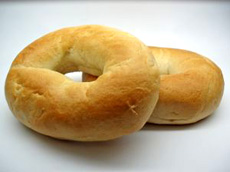 from a bagel or donut. Robert Bohannon, a molecular scientist from Durham, North Carolina, has developed a way to add caffeine to baked goods and is now pitching the concept to chains including Krispy Kreme, Starbucks and Dunkin’ Donuts. He solved the challenge of masking the bitterness of caffeine so it can be used in food and pastry products, and Buzz Donuts and Buzzed Bagels are ready to go. from a bagel or donut. Robert Bohannon, a molecular scientist from Durham, North Carolina, has developed a way to add caffeine to baked goods and is now pitching the concept to chains including Krispy Kreme, Starbucks and Dunkin’ Donuts. He solved the challenge of masking the bitterness of caffeine so it can be used in food and pastry products, and Buzz Donuts and Buzzed Bagels are ready to go.
Dannon Adds To Probiotic Yogurts. Following the successful launch of Activia last year, The Dannon Company, Inc. has announced three new probiotic yogurt-based products with functional benefits to be introduced this year: DanActive dairy drink, reformulated versions of Danimals drinks and lowfat yogurt, and Activia Light nonfat yogurt. Activia contains a unique probiotic culture*, Bifidus Regularis†, which is clinically proven to help regulate the digestive system when eaten daily for two weeks. Probiotics (meaning “for life” in Latin), popular for more than a decade in Europe, are living microorganisms, usually lactic acid bacteria, that, when consumed in sufficient numbers, can provide health benefits that go beyond basic nutrition. The 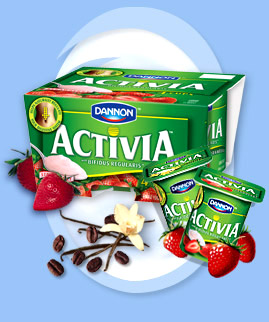 benefits of probiotics are due, in large part, to the effects of these so-called "friendly" bacteria on different intestinal functions and are strain-specific. Depending on the specific strain of probiotic culture in each product, benefits associated with immune function, gastrointestinal function and oral health can be realized. Note that yogurt with active cultures that are beneficial to the digestive system have been available for some time: probiotics are part of the functional foods movement, where products have an added function beyond the basic nutrition. DanActive, launching nationwide this month, is a cultured probiotic dairy drink that has been clinically proven to help naturally strengthen the body’s defenses when consumed daily. It contains the proprietary probiotic L. casei Immunitas culture, clinically proven to work in the digestive track, where 70 percent of a person’s immune system is located. It was introduced in Europe in 1994 and later in Asia under the brand name Actimel. The existing Danimals line of lowfat yogurt cups and drinks made for children has been reformulated to contain no artificial colors, no artificial flavors and no high fructose corn syrup—and will include Lactobacillus GG (LGG), which has been clinically proven to have positive effects on gastrointestinal function, the function of the immune system and the maintenance of oral health. benefits of probiotics are due, in large part, to the effects of these so-called "friendly" bacteria on different intestinal functions and are strain-specific. Depending on the specific strain of probiotic culture in each product, benefits associated with immune function, gastrointestinal function and oral health can be realized. Note that yogurt with active cultures that are beneficial to the digestive system have been available for some time: probiotics are part of the functional foods movement, where products have an added function beyond the basic nutrition. DanActive, launching nationwide this month, is a cultured probiotic dairy drink that has been clinically proven to help naturally strengthen the body’s defenses when consumed daily. It contains the proprietary probiotic L. casei Immunitas culture, clinically proven to work in the digestive track, where 70 percent of a person’s immune system is located. It was introduced in Europe in 1994 and later in Asia under the brand name Actimel. The existing Danimals line of lowfat yogurt cups and drinks made for children has been reformulated to contain no artificial colors, no artificial flavors and no high fructose corn syrup—and will include Lactobacillus GG (LGG), which has been clinically proven to have positive effects on gastrointestinal function, the function of the immune system and the maintenance of oral health.
*Note that all yogurt is made by curdling milk with purified cultures of two special bacteria, Lactobacillus bulgaricus and Streptococcus thermophilus. In addition, for many years, a probiotic strain of live bacteria, Lactobacillus acidophilus, has been added to some yogurts (generally low-fat varieties) for certain health purposes, has been added to some American yogurts for decades. It helps the digestive system by making the environment hostile for undesired organisms, assists during digestion, and has been shown in some studies to improve gastrointestinal function and boost the immune system.
†It is important to stress that the Dannon “unique cultures” are not scientific names but trade names designed to sound and look like scientifically named organisms. The scientific name is Bifidobacterium animalis, which cannot be trademarked; Dannon has trademarked Bifidus Digestivum, also known as Bifidus Regularis, Bifidobacterium Lactis, Bifidus Essensis and Bifidus Activo. In scientific classification, a species is assigned a two-part name. The genus is listed first (with its leading letter capitalized), followed by a second term (all in small caps). For example, humans belong to the genus Homo and are in the species sapiens; both terms are written in italics. In contrast, the two words of these trade names are both written with their first letters capitalized and never in italics. Source: Wikipedia.
Drink Coffee, Save The Songbird. American Bird Conservancy (ABC) is offering Cerulean Warbler Conservation Coffee, a shade grown coffee from plantations in Central Colombia that the Cerulean Warbler—a declining songbird that nests in North America—depends upon during the winter. Proceeds from the coffee sales will be used 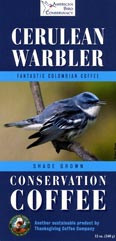 to maintain the shade plantations and an adjacent Cerulean Warbler forest reserve. By purchasing this premium coffee, those who care about the environment can help traditional coffee cooperatives maintain shade plantations, preserving habitats for the Cerulean Warbler and other migratory songbirds. Shade grown coffee plantations are at risk of being converted to sun coffee and other cash crops, resulting in a loss of forest cover and bird habitat. The loss of these plantations is cited as a reason for the bird’s decline. The coffee can be ordered from abcbirds.org. Paul Katzeff, roastmaster for Thanksgiving Coffee, describes the coffee as “the best Colombian coffee I have tasted, and I have been roasting coffee since 1969.” He extols its “heavy body, silky smooth notes of cashew and apricot, and a long fruity finish. If you like coffee ice cream, you will love this classic Colombian Coffee.” Learn more about the plight of songbirds, bird friendly coffee and shade grown coffee. to maintain the shade plantations and an adjacent Cerulean Warbler forest reserve. By purchasing this premium coffee, those who care about the environment can help traditional coffee cooperatives maintain shade plantations, preserving habitats for the Cerulean Warbler and other migratory songbirds. Shade grown coffee plantations are at risk of being converted to sun coffee and other cash crops, resulting in a loss of forest cover and bird habitat. The loss of these plantations is cited as a reason for the bird’s decline. The coffee can be ordered from abcbirds.org. Paul Katzeff, roastmaster for Thanksgiving Coffee, describes the coffee as “the best Colombian coffee I have tasted, and I have been roasting coffee since 1969.” He extols its “heavy body, silky smooth notes of cashew and apricot, and a long fruity finish. If you like coffee ice cream, you will love this classic Colombian Coffee.” Learn more about the plight of songbirds, bird friendly coffee and shade grown coffee.
Where’s The Fruit? Over half of the most aggressively advertised children’s foods that prominently feature fruit on their packaging contain no fruit at all, according to a study released today by the Strategic Alliance for Healthy Food and Activity Environments. The study, called “Where’s the Fruit?” reveals that 51% of these products do not contain fruit, and another 16% contain only minimal amounts of fruit despite images of fruits on the packaging and use of words such as “fruity,” “fruit flavors” and “berry.” This is clearly deceptive, according to Leslie Mikkelsen, a registered dietician with the Strategic Alliance and lead author of the study. “Food and beverage companies are some of the most sophisticated communicators in the world and are clearly capable of accurately reflecting what is in their products if they wanted 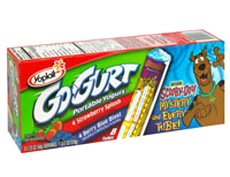 to.” Culprits include Yoplait’s Strawberry Splash Go-Gurt Yogurt which does not contain any actual fruit, and Berry Berry Kix, which, despite fruit images and reference to “natural fruit flavors,” contains no fruit. Only 27% of the products examined contained fruit (in the form of fruit purée or fruit from concentrate). Six percent were 100% fruit juice; however fruit juice does not contain the equivalent fiber, vitamins and minerals of whole fruit. Dr. Andria Ruth, a pediatrician for the Diabetes Resource Center of Santa Barbara, commented that “these food companies are making parents’ jobs even harder by using misleading packaging to lead them to think that they are making a healthy choice when they are not.” To support healthy eating habits, the Strategic Alliance is calling on food manufacturers to stop marketing children’s food products as something that they are not and to begin providing more nutritious food options. The Strategic Alliance for Healthy Food and Activity Environments is a coalition of California’s leading public health and health care, parks and recreation, transportation and nutrition organizations committed to promoting environmental and policy changes to support healthy eating and physical activity. to.” Culprits include Yoplait’s Strawberry Splash Go-Gurt Yogurt which does not contain any actual fruit, and Berry Berry Kix, which, despite fruit images and reference to “natural fruit flavors,” contains no fruit. Only 27% of the products examined contained fruit (in the form of fruit purée or fruit from concentrate). Six percent were 100% fruit juice; however fruit juice does not contain the equivalent fiber, vitamins and minerals of whole fruit. Dr. Andria Ruth, a pediatrician for the Diabetes Resource Center of Santa Barbara, commented that “these food companies are making parents’ jobs even harder by using misleading packaging to lead them to think that they are making a healthy choice when they are not.” To support healthy eating habits, the Strategic Alliance is calling on food manufacturers to stop marketing children’s food products as something that they are not and to begin providing more nutritious food options. The Strategic Alliance for Healthy Food and Activity Environments is a coalition of California’s leading public health and health care, parks and recreation, transportation and nutrition organizations committed to promoting environmental and policy changes to support healthy eating and physical activity.
Another Reason To Snack On Walnuts. A new study published in Nutrition Journal suggests that walnuts, rich in alpha-linolenic acid (ALA), an essential omega-3 fatty acid, help the human skeletal system by decreasing the breakdown of bone. Conducted by Penn State researchers, the study is the first human study evaluating the effect of plant-based sources of omega-3 fatty acids (ALA) on bone health. The results suggest higher consumption of ALA leads to a reduction in bone turnover. Walnuts are unique as one as one of the most nutrient-dense whole food sources of ALA. Numerous studies have already suggested that omega-3s reduce inflammation, heart and vascular disease risk, decrease insulin resistance, assist with weight management and may be beneficial in brain function. Ten million men and women in the U.S. are estimated to have the bone-deteriorating disease osteoporosis, according to the National Osteoporosis Foundation.
Product Watch
Spyke Your Beer. This surprising product comes from beer giant Anheuser Busch, in an attempt to woo younger drinkers—especially women who tend to like beer less than 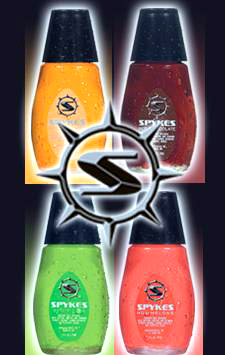 men—with something fun and gimmicky. Spykes is a fruity beer additive, a malt liquor with a 12% alcohol content that can be mixed or taken as a shot, and is slightly caffeinated, for a kick. Packaged in 2-ounce bottles, sold for up to $2.00 per bottle, Spykes is available in Spicy Mango, Spicy Lime, Hot Melon and Hot Chocolate (all of the flavors have a slight, jalapeño-like burn on the finish). The bottles can be tossed into one’s purse or pocket and can be mixed with just about anything, including gin and vodka—although Anheuser Bush hopes the flavor spikes will encourage more beer sales, since beer makers have been losing market share to distilled spirits for the last five years. The Belgians love their fruit lambics, and Americans have been squeezing fresh lime wedges into longneck Coronas for decades. Perhaps Spykes will spark a new generation of beer-lovers. men—with something fun and gimmicky. Spykes is a fruity beer additive, a malt liquor with a 12% alcohol content that can be mixed or taken as a shot, and is slightly caffeinated, for a kick. Packaged in 2-ounce bottles, sold for up to $2.00 per bottle, Spykes is available in Spicy Mango, Spicy Lime, Hot Melon and Hot Chocolate (all of the flavors have a slight, jalapeño-like burn on the finish). The bottles can be tossed into one’s purse or pocket and can be mixed with just about anything, including gin and vodka—although Anheuser Bush hopes the flavor spikes will encourage more beer sales, since beer makers have been losing market share to distilled spirits for the last five years. The Belgians love their fruit lambics, and Americans have been squeezing fresh lime wedges into longneck Coronas for decades. Perhaps Spykes will spark a new generation of beer-lovers.
Trends
Vodka Overload. Nearly 260 vodka brands were introduced in the U.S. from 2001 to 2006, according to Adams Beverage Group. Needless to say, these are not bargain brands: in fancy bottles and fancier flavors, vodkas now account for about a quarter of all new hard-liquor brands, more than any other spirit. Seven years ago a dotcom millionaire might start a vineyard; today, he or she launches a distillery to create a vodka brand, no doubt lured by the billions made by Sidney Frank, who founded Grey Goose in 1997 and sold it to Bacardi in 2004 for $2 billion. Craig Dieffenbach, who sold SeattleOnline, an online city guide, for millions the year Grey Goose was founded, started up Hendrix Electric Vodka last year (named after famed musician Jimi Hendrix). The bottle has a purple haze (it’s purple and glows in the dark). A caffeine-infused 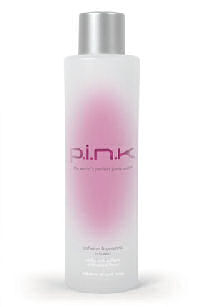 vodka called p.i.n.k., a huckleberry-flavored vodka called 44° North (the latitude of the distillery), and Zodiac, which comes in 12 different bottles, one for each zodiac sign. An entrepreneur in the Florida Keys came up with the idea for a Key lime vodka. A New York entrepreneur launched Hamptons Vodka, hoping to grab the cachet of the tony leisure spot. Hundreds more ideas proliferate, but will never make it to the shelf. So far, the proliferation of new niche vodkas has had only a negligible impact on sales of the big brands such as Smirnoff and Stolichnaya, which sell millions of cases a year. Small vodka producers, in contrast, often sell no more than a few thousand. But big companies are taking note of the trend, launching their own niche products, and, in rare instances, buying smaller brands. If you’re dying to have your own vodka brand, you can do it without investing millions. For for $15,000, Modern Spirits of California will guide you to produce 10 cases of your own superpremium vodka. Click for more information about Modern Spirits custom vodka. vodka called p.i.n.k., a huckleberry-flavored vodka called 44° North (the latitude of the distillery), and Zodiac, which comes in 12 different bottles, one for each zodiac sign. An entrepreneur in the Florida Keys came up with the idea for a Key lime vodka. A New York entrepreneur launched Hamptons Vodka, hoping to grab the cachet of the tony leisure spot. Hundreds more ideas proliferate, but will never make it to the shelf. So far, the proliferation of new niche vodkas has had only a negligible impact on sales of the big brands such as Smirnoff and Stolichnaya, which sell millions of cases a year. Small vodka producers, in contrast, often sell no more than a few thousand. But big companies are taking note of the trend, launching their own niche products, and, in rare instances, buying smaller brands. If you’re dying to have your own vodka brand, you can do it without investing millions. For for $15,000, Modern Spirits of California will guide you to produce 10 cases of your own superpremium vodka. Click for more information about Modern Spirits custom vodka.
What We’re Eating. ACNielsen Global Services’ latest Executive News Report, titled “What’s Hot Around the Globe—Insights on Growth in Food & Beverage Products,” shows that it’s a small world after all. In Europe, North America, Asia Pacific, Latin America, and Emerging Markets, there’s a commonality in foods that are showing double-digit growth. The fastest-growing food purchased by consumers worldwide is drinkable yogurt, showing a concern for health and nutrition as well as convenience in portion size and portability, and value. Yogurt, in both solid and drinkable forms, also has child-appeal via flavors and licensed characters. A total of nine product categories grew by double digits in 2006 compared to 2005:
- Drinkable Yogurt 18%
- Fresh/Refrigerated Soup / Bouillon / Stock 18%
- Fresh Herbs / Spices / Seasoning 17%
- Fresh Fish and Seafood 12%
- Alcoholic Cider 11%
- Fresh Ready-to-Eat Salad 10%
- Baby Formula 10%
- Dairy-Based Drinks 10%
- Frozen Meal Starters 10%
1.22.07
News
32nd Winter Fancy Food Show in San Francisco. As you read this, THE NIBBLE staff will be in the middle of the Winter Fancy Food Show: a whirlwind of more than 80,000 products, including 1,400 new product introductions, from which we will try to find the most outstanding to present to you. More than 16,000 food industry professionals will peruse the 1,800 exhibiting companies to find merchandise for their stores, catalogs, web-businesses, catering businesses, etc. The Winter Fancy Food Show is the second largest exhibition of specialty food products in the U.S.—the largest is the Summer Fancy Food Show held in July in New York City. Both are presented by the National Association for Specialty Food Trade, the industry association representing specialty foods.
“Island Jerk” New Kettle Chip. The third annual Kettle Foods People’s Choice campaign participants voted Island Jerk™ as the next Kettle™ brand Potato Chip flavor. It was a tight three-way race among Island Jerk™, Dragon 5 Spice, and Twisted 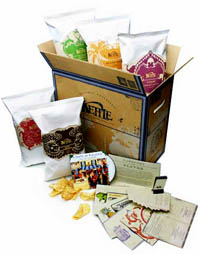 Chili Lime, but the Jamaican jerk spice won out. Jerk spice is a smoky-sweet combination of chili pepper, black pepper, cinnamon, allspice, cumin and thyme. Left in the dust were Aztec Chocolate and Royal Indian Curry. It was not necessary to taste the chips, so many people may have voted on the concept idea. We at THE NIBBLE liked all of the flavors (Aztec Chocolate is a great chip flavor), but the consensus was that Island Jerk was the best “food chip”: i.e., it fit in the best with sandwiches, burgers, etc. You can still taste them all (and we highly recommend it): a limited number of Party Packs containing all five-ounce bags of each flavor flavors are still available and can be purchased online. The cost is $19.95 each, or two for $32.95, including shipping. The Party pack includes “A Taste of Putumayo: Music for Every Palate” music sampler CD and materials for throwing a chip-tasting party. The Island Jerk chip will be in the stores by summer. This is the first year that Kettle did not declare a tie winner. Past People's Choice winners include Buffalo Bleu, Cheddar Beer™, Spicy Thai™ and Tuscan Three Cheese. Chili Lime, but the Jamaican jerk spice won out. Jerk spice is a smoky-sweet combination of chili pepper, black pepper, cinnamon, allspice, cumin and thyme. Left in the dust were Aztec Chocolate and Royal Indian Curry. It was not necessary to taste the chips, so many people may have voted on the concept idea. We at THE NIBBLE liked all of the flavors (Aztec Chocolate is a great chip flavor), but the consensus was that Island Jerk was the best “food chip”: i.e., it fit in the best with sandwiches, burgers, etc. You can still taste them all (and we highly recommend it): a limited number of Party Packs containing all five-ounce bags of each flavor flavors are still available and can be purchased online. The cost is $19.95 each, or two for $32.95, including shipping. The Party pack includes “A Taste of Putumayo: Music for Every Palate” music sampler CD and materials for throwing a chip-tasting party. The Island Jerk chip will be in the stores by summer. This is the first year that Kettle did not declare a tie winner. Past People's Choice winners include Buffalo Bleu, Cheddar Beer™, Spicy Thai™ and Tuscan Three Cheese.
Cereal: The New Airport Food. Travelers who have looked for better options than the fast-food purveyors at airports have a more wholesome option: cereal. Cereality, a 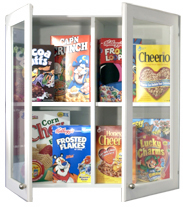 cereal bar/theme restaurant established in 2003 at Arizona State University, has been slinging cereal to great success beyond university campuses. Office workers love it, travelers love it too. The company has opened two stands at a Newark Liberty Airport, and will open a Cereality Express next month, followed shortly by one at JFK Airport in New York, and then a full 200-square-foot kiosk at O’Hare International Airport by late winter. Cereal isn’t just for early-morning travelers: while it is still primarily thought of as a breakfast food, it is also seen as nutritious and a comfort food. Given the choice of food available at airports, a bowl of Cheerios® or oatmeal with milk and bananas will often sound like a better option, regardless of the time of day. The Cereality concept allows customers to choose customized oatmeal or cold cereal concoctions with choices of nostalgic cereals such as Quisp, mix-ins, toppings and flavored milk for $4. cereal bar/theme restaurant established in 2003 at Arizona State University, has been slinging cereal to great success beyond university campuses. Office workers love it, travelers love it too. The company has opened two stands at a Newark Liberty Airport, and will open a Cereality Express next month, followed shortly by one at JFK Airport in New York, and then a full 200-square-foot kiosk at O’Hare International Airport by late winter. Cereal isn’t just for early-morning travelers: while it is still primarily thought of as a breakfast food, it is also seen as nutritious and a comfort food. Given the choice of food available at airports, a bowl of Cheerios® or oatmeal with milk and bananas will often sound like a better option, regardless of the time of day. The Cereality concept allows customers to choose customized oatmeal or cold cereal concoctions with choices of nostalgic cereals such as Quisp, mix-ins, toppings and flavored milk for $4.
Product Watch
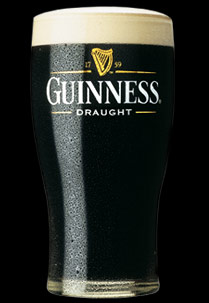 Have A Guinness—Toasted And Buttered. The world’s largest alcoholic beverage firm, Diageo, has teamed up with an Irish baker to put its iconic Guinness beer and Ireland’s signature drink, brewed since 1759, into bread. Bread is the first step in a move to expand the Guinness brand, sales of which have been slipping in Ireland over the last two years, into a wider range of foods. The bread has been launched in Ireland and the U.K. in the supermarket giant, Tesco, and will be available shortly by license in U.S. supermarkets. Now one can “toast” to the success of Guinness Whole Grain Bread, a wheat bread that contains 17% Guinness. Although the alcohol content evaporates during baking, the strong Guinness taste remains. Have A Guinness—Toasted And Buttered. The world’s largest alcoholic beverage firm, Diageo, has teamed up with an Irish baker to put its iconic Guinness beer and Ireland’s signature drink, brewed since 1759, into bread. Bread is the first step in a move to expand the Guinness brand, sales of which have been slipping in Ireland over the last two years, into a wider range of foods. The bread has been launched in Ireland and the U.K. in the supermarket giant, Tesco, and will be available shortly by license in U.S. supermarkets. Now one can “toast” to the success of Guinness Whole Grain Bread, a wheat bread that contains 17% Guinness. Although the alcohol content evaporates during baking, the strong Guinness taste remains.
Trends
Peter Picked Many Peppers. Just when you were mastering single origin chocolates, artisan salts and Ethiopian coffees, the latest demand on your food connoisseurship is 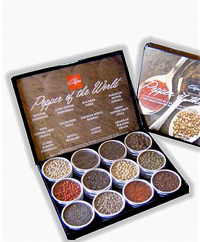 varietal peppercorns. Pepper has been the world’s most popular spice for more than a thousand years (salt isn’t a spice, which is defined as the dried seeds, buds, fruit, bark, roots or flower parts of plants). Originally from southeast India, you now can buy peppercorns from Ecuador, Indonesia, Malaysia and Vietnam—and use them to make meat crusts and ice cream as well as to grind onto prepared food. One of our recommended holiday gifts was Chef Stefan’s Epicurean Pepper Collection: twelve different peppers including Aleppo, Cubeb Berries, Grains of the Paradise, Green Peppercorns, Jamaican, Long Pepper, Malabar, Moula, Muntok, Pink Peppercorns, Sarawak White and Tellicherry. There are food pairing suggestions for each varietal (available at SaltsOfTheWorld.com). Next month, THE NIBBLE will delve into the topic of varietal peppercorns in spicy detail. varietal peppercorns. Pepper has been the world’s most popular spice for more than a thousand years (salt isn’t a spice, which is defined as the dried seeds, buds, fruit, bark, roots or flower parts of plants). Originally from southeast India, you now can buy peppercorns from Ecuador, Indonesia, Malaysia and Vietnam—and use them to make meat crusts and ice cream as well as to grind onto prepared food. One of our recommended holiday gifts was Chef Stefan’s Epicurean Pepper Collection: twelve different peppers including Aleppo, Cubeb Berries, Grains of the Paradise, Green Peppercorns, Jamaican, Long Pepper, Malabar, Moula, Muntok, Pink Peppercorns, Sarawak White and Tellicherry. There are food pairing suggestions for each varietal (available at SaltsOfTheWorld.com). Next month, THE NIBBLE will delve into the topic of varietal peppercorns in spicy detail.
Volvic Natural Lemon & Natural Orange. About 4 years ago when we first tasted Volvic’a orange-flavored, unsweetened water, we were charmed. At that time, there 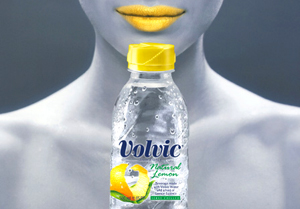 were only orange-flavored seltzers. We loved the natural orange flavor in Volvic’s crisp spring water. The product has re-emerged sweetened, with 14g of sugar in a 500 ml (1.05 pint) bottle. We personally don’t care for the whole Fruitwater concept of flavored, sweetened waters—we prefer our water flavored but without the sugar, and we loved the product as Glaceau originally made it, as unsweetened, fruit-flavored water. But, cater to the soda-drenched American palate, and you can get Americans to drink “water” as long as you don’t carbonate it (NB: soda is flavored, sweetened, carbonated water). Volvic, a French water company does it better than the Americans. The two Volvic flavors start with a better-quality water, and have a very different flavor profile: they taste like dilute orange juice and dilute lemonade, respectively. If you love your orange juice or your lemonade, think of them as lower-calorie spa versions. Available at fine food stores or at Volvic-na.com. If it hurts you to give up your O.J. when you’re on a diet, at 30 calories for 8 ounces, we endorse Volvic Natural Orange and Natural Lemon. were only orange-flavored seltzers. We loved the natural orange flavor in Volvic’s crisp spring water. The product has re-emerged sweetened, with 14g of sugar in a 500 ml (1.05 pint) bottle. We personally don’t care for the whole Fruitwater concept of flavored, sweetened waters—we prefer our water flavored but without the sugar, and we loved the product as Glaceau originally made it, as unsweetened, fruit-flavored water. But, cater to the soda-drenched American palate, and you can get Americans to drink “water” as long as you don’t carbonate it (NB: soda is flavored, sweetened, carbonated water). Volvic, a French water company does it better than the Americans. The two Volvic flavors start with a better-quality water, and have a very different flavor profile: they taste like dilute orange juice and dilute lemonade, respectively. If you love your orange juice or your lemonade, think of them as lower-calorie spa versions. Available at fine food stores or at Volvic-na.com. If it hurts you to give up your O.J. when you’re on a diet, at 30 calories for 8 ounces, we endorse Volvic Natural Orange and Natural Lemon.
1.15.07
News
Milk Dilutes Health Benefits Of Tea. While millions of people have been drinking more tea, encouraged by studies that show it can reduce the risk of heart disease and 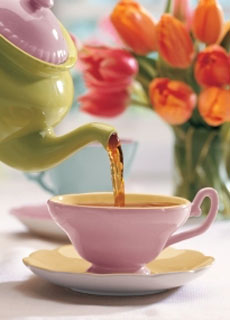 stroke, new research has found that adding milk negates those benefits. According to researchers at the Charite Hospital at the University of Berlin, Germany, the casein (protein) in milk interacts with tea, decreasing the concentration of catechin, the flavonoids in tea that protect against heart disease. The beneficial effects of drinking black tea are completely prevented by the addition of milk, said Dr. Verena Stangl, a cardiologist at the hospital. “If you want to drink tea to have the beneficial health effects, you have to drink it without milk. That is clearly shown by our experiments,” she told Reuters. The findings, reported in the European Heart Journal, could explain why countries such as Great Britain, where tea is regularly consumed with milk, have not shown a decreased risk of heart disease and stroke from drinking tea, whereas Asian countries, which do not consume milk with tea, show the benefit. stroke, new research has found that adding milk negates those benefits. According to researchers at the Charite Hospital at the University of Berlin, Germany, the casein (protein) in milk interacts with tea, decreasing the concentration of catechin, the flavonoids in tea that protect against heart disease. The beneficial effects of drinking black tea are completely prevented by the addition of milk, said Dr. Verena Stangl, a cardiologist at the hospital. “If you want to drink tea to have the beneficial health effects, you have to drink it without milk. That is clearly shown by our experiments,” she told Reuters. The findings, reported in the European Heart Journal, could explain why countries such as Great Britain, where tea is regularly consumed with milk, have not shown a decreased risk of heart disease and stroke from drinking tea, whereas Asian countries, which do not consume milk with tea, show the benefit.
Photo courtesy of Stash Tea.
The First Chocolate Stamp? The U.S. Postal Service didn’t mention of there had been other chocolate-themed stamps before it, but the new “With Love and Kisses” stamp features an unmistakable brand. In time for Valentine’s Day greeting cards and to commemorate the 100th 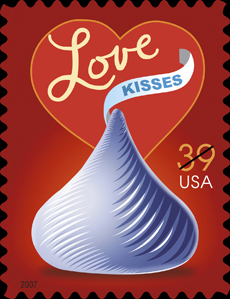 anniversary of Hershey’s Kisses, a colorful new stamp featuring a Hershey’s Kisses chocolate and a big red heart was issued last week. The iconic shape of Kisses has not changed since The Hershey Company introduced the milk-chocolate candies in 1907 (they were wrapped by hand until the process was automated in 1921). Kisses have been available year-round since their debut, except from 1942 to 1949, when silver foil was rationed during World War II. Kisses chocolates wrapped in red and silver foil were introduced in 1986 in honor of Valentine’s Day, and they now can be found in a variety of seasonal colors. The Postal Service began issuing its popular Love stamps in 1973. Over the years the stamps have featured a delightful assortment of designs including heart motifs, colorful flowers and the word “LOVE" itself.” They’re popular for wedding and engagement invitations, so if you have plans, stock up. anniversary of Hershey’s Kisses, a colorful new stamp featuring a Hershey’s Kisses chocolate and a big red heart was issued last week. The iconic shape of Kisses has not changed since The Hershey Company introduced the milk-chocolate candies in 1907 (they were wrapped by hand until the process was automated in 1921). Kisses have been available year-round since their debut, except from 1942 to 1949, when silver foil was rationed during World War II. Kisses chocolates wrapped in red and silver foil were introduced in 1986 in honor of Valentine’s Day, and they now can be found in a variety of seasonal colors. The Postal Service began issuing its popular Love stamps in 1973. Over the years the stamps have featured a delightful assortment of designs including heart motifs, colorful flowers and the word “LOVE" itself.” They’re popular for wedding and engagement invitations, so if you have plans, stock up.
Follow-Up on Foie. Five months after the city ordered Chicago restaurants to stop selling foie gras, it is proving to be a waste of legislators’ time. The initiative was urged by animal rights interest groups, and resulted in what Mayor Richard Daley has called 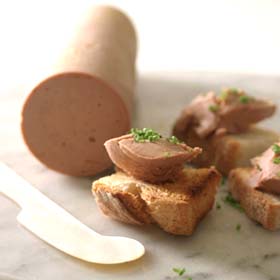 it the “silliest” ordinance the City Council has ever passed. Many restaurants have simply continued to serve foie gras to please their clientele: While the city ordinance bans the sale of foie gras, establishments can give it away—for example, by selling a salad with a complimentary side of foie gras, or by including it as a free course “courtesy of management” with a tasting dinner. While there have been only a handful of complaints about non-compliance, the Health Department has no time to pursue any violations, needing to focus its time on protecting the public from situations that actually are harmful. “Our mission is to protect human health and not the health of geese and ducks,” said Health Department spokesman Tim Hadac, who called the ban the department’s lowest priority. Even Alderman Joe Moore, who sponsored the legislation, has said that he realizes the Health Department has more pressing issues. As other cities, under pressure from animal activist groups, are forced to consider legislation, Chicago will hopefully stand as an example that time can be put to better use. We at THE NIBBLE have previously commented that it is easy for activists to pick on a tiny, unorganized industry like foie gras, which impacts very few animals because the food is eaten by so few people. The activists feel that geese are overfed in a cruel fashion. If they wish to truly help animals, why not pursue a significant issue, such as the fact that many millions of lobsters and crabs are plunged live into boiling water each year? Because it is much easier and safer to make an issue of an animal that few people are familiar with or want to eat, than try to deprive Americans of their lobsters. Foie gras activists have also damaged private property to make their views “heard,” breaking into and defacing facilities where foie gras is produced and sold. Whatever your personal views on foie gras, this has not been an admirable example of people campaigning for positive change. it the “silliest” ordinance the City Council has ever passed. Many restaurants have simply continued to serve foie gras to please their clientele: While the city ordinance bans the sale of foie gras, establishments can give it away—for example, by selling a salad with a complimentary side of foie gras, or by including it as a free course “courtesy of management” with a tasting dinner. While there have been only a handful of complaints about non-compliance, the Health Department has no time to pursue any violations, needing to focus its time on protecting the public from situations that actually are harmful. “Our mission is to protect human health and not the health of geese and ducks,” said Health Department spokesman Tim Hadac, who called the ban the department’s lowest priority. Even Alderman Joe Moore, who sponsored the legislation, has said that he realizes the Health Department has more pressing issues. As other cities, under pressure from animal activist groups, are forced to consider legislation, Chicago will hopefully stand as an example that time can be put to better use. We at THE NIBBLE have previously commented that it is easy for activists to pick on a tiny, unorganized industry like foie gras, which impacts very few animals because the food is eaten by so few people. The activists feel that geese are overfed in a cruel fashion. If they wish to truly help animals, why not pursue a significant issue, such as the fact that many millions of lobsters and crabs are plunged live into boiling water each year? Because it is much easier and safer to make an issue of an animal that few people are familiar with or want to eat, than try to deprive Americans of their lobsters. Foie gras activists have also damaged private property to make their views “heard,” breaking into and defacing facilities where foie gras is produced and sold. Whatever your personal views on foie gras, this has not been an admirable example of people campaigning for positive change.
Photo courtesy of CaviarRusse.com.
Kosher Food Championship: Free Admission. Move over, Iron Chef wannabes: kosher cooking contestants are strutting their stuff in the first national “Simply Great Jewish Food” live cooking competition. The finals, more like the Pillsbury Bake-Off Gone Kosher, are open to the public (free admission), and will be held at the New York Marriott Marquis Hotel at 45th Street and Broadway on Thursday, February 1 from 11:00 a.m. to 1:00 p.m. Six finalists, who have already made it to the top of their regional competitions, will cook and be judged. The competition is sponsored by Manishewitz, a leading producer of kosher foods for 118 years. The Grand Prize, valued at $20,000, includes a complete set of GE Profile kitchen appliances with a total estimated retail value of $10,000; and a $5,000 check from Manischewitz, and the title of “National Simply Manischewitz Champion.”
Product Watch
Gold Peak Iced Tea. This week we picked up a Gold Peak Iced Tea. The producer is Beverage Partners Worldwide, which turns out to be a joint venture between The 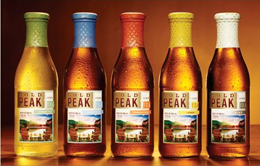 Coca-Cola Company and Nestlé that focuses on black teas and Enviga, a sparkling green tea beverage that has launched in Europe, is headed to the U.S., and is proven to burn calories (although not at any significant rate to engender weight loss). While the website is a bit overproduced by designers who think others have nothing else to do with their time but wait for fancy pages to load, there’s a a heavy lifestyle story going on at GoldPeakTea.com, complete with a fictional town where people sit in Adirondack chairs and gaze out at an idyllic mountain lake, drinking their Gold Peak iced tea, and introducing about different characters who prefer different flavors. The Diet Iced Tea we selected was the best we’d ever had for a sweetened no-calorie product: superb, strong black tea flavor with a sweetener of aspartame and acesulfame potassium that tasted exactly like sugar. Other flavors include Sweetened, Unsweetened, Lemon and Green Tea. You can phone to find a local retailer: 1.800.488.2267. Gold Peak is certified kosher by OU. Coca-Cola Company and Nestlé that focuses on black teas and Enviga, a sparkling green tea beverage that has launched in Europe, is headed to the U.S., and is proven to burn calories (although not at any significant rate to engender weight loss). While the website is a bit overproduced by designers who think others have nothing else to do with their time but wait for fancy pages to load, there’s a a heavy lifestyle story going on at GoldPeakTea.com, complete with a fictional town where people sit in Adirondack chairs and gaze out at an idyllic mountain lake, drinking their Gold Peak iced tea, and introducing about different characters who prefer different flavors. The Diet Iced Tea we selected was the best we’d ever had for a sweetened no-calorie product: superb, strong black tea flavor with a sweetener of aspartame and acesulfame potassium that tasted exactly like sugar. Other flavors include Sweetened, Unsweetened, Lemon and Green Tea. You can phone to find a local retailer: 1.800.488.2267. Gold Peak is certified kosher by OU.
Trends
Restaurant Trends: Beyond Trendy? If you’re just learning about the Brazilian açai berry and Peruvian peri-peri sauce, how do you feel about boursin-stuffed kangaroo nachos with roasted avocado corn salad and huckleberry habañero demi-glace? Market research publisher Packaged Facts reports in Emerging Food Concept Trends in Foodservice, that what sound like cutting-edge dishes are finding their way onto 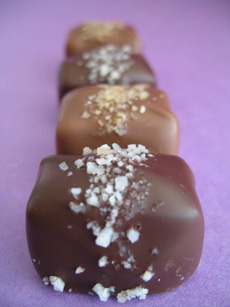 menus at mainstream restaurants from coast to coast. In fact, the study says, these “emerging concepts” are driving the future of what could be considered a redefinition of comfort food—a combination of retro, artisan, global flavors and other markers. The trends can be seen not just at white table cloth and ethnic restaurants but at chain restaurants and on retail shelves. Products such as Fran’s Chocolates’ chocolate-covered caramels topped with Welsh smoked sea salt (milk chocolate caramels in photo at right) and Kettle Brand’s roasted red pepper with goat cheese potato chips have been successful in the market for two years. And, the study notes, the once exotic and rare portobello mushroom is now available as a portobello mushroom burger at Carl's Jr. fast food restaurants, for $6.00. Combining comfort and familiarity, restaurants are also offering gourmet Fluffernutter sandwiches, crab-stuffed tater tots and truffled macaroni and cheese. We’re waiting for Taco Bell to offer the kangaroo nachos. menus at mainstream restaurants from coast to coast. In fact, the study says, these “emerging concepts” are driving the future of what could be considered a redefinition of comfort food—a combination of retro, artisan, global flavors and other markers. The trends can be seen not just at white table cloth and ethnic restaurants but at chain restaurants and on retail shelves. Products such as Fran’s Chocolates’ chocolate-covered caramels topped with Welsh smoked sea salt (milk chocolate caramels in photo at right) and Kettle Brand’s roasted red pepper with goat cheese potato chips have been successful in the market for two years. And, the study notes, the once exotic and rare portobello mushroom is now available as a portobello mushroom burger at Carl's Jr. fast food restaurants, for $6.00. Combining comfort and familiarity, restaurants are also offering gourmet Fluffernutter sandwiches, crab-stuffed tater tots and truffled macaroni and cheese. We’re waiting for Taco Bell to offer the kangaroo nachos.
Water Trends. “Still or sparkling” is to water as 20th century as “milk or dark” is to chocolate: an antiquated way of looking at the category. With an ever-growing demand for newer, better, more hip, more exclusive and more rare waters, designer water in the U.S. has replaced tea and soda as the beverage that has captured the public fancy. It’s chic, trendy and healthy: the trifecta! Expect to see more high-end 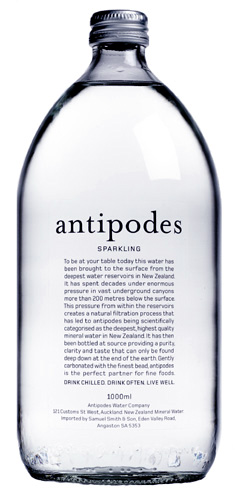 brands to pour into the U.S. market in 2007. Designer waters from glaciers, melted icebergs and ancient restored European sources will compete with waters enriched with extra molecules of oxygen and herbal essences. Given the money to be made in new water brands, drilling and development of new artesian water sources in remote regions such as the Canadian Arctic and elsewhere is underway. Designer brands from Japan, New Zealand and the Pacific islands, which offer a crisper and cleaner taste due to underlying volcanic rock formation which filters the water, are on the rise (note the success of Fiji Water). New source from areas not even associated with fine water have even join the fray: look for water from South Africa and Brazil. And of course, in the American market, provenance is secondary to packaging is king: companies are putting thought into the look and feel of their bottles to create the perfect brand image. Water bars, like wine bars, previously seen only in Los Angeles, have expanded to other cities: people can order from the water menu and pair foods that match. Each month, THE NIBBLE reviews one fine water: You can read about it in the monthly Table of Contents in the “Drink Up” area, and see the entire archives in our Bottled Waters product reviews section. brands to pour into the U.S. market in 2007. Designer waters from glaciers, melted icebergs and ancient restored European sources will compete with waters enriched with extra molecules of oxygen and herbal essences. Given the money to be made in new water brands, drilling and development of new artesian water sources in remote regions such as the Canadian Arctic and elsewhere is underway. Designer brands from Japan, New Zealand and the Pacific islands, which offer a crisper and cleaner taste due to underlying volcanic rock formation which filters the water, are on the rise (note the success of Fiji Water). New source from areas not even associated with fine water have even join the fray: look for water from South Africa and Brazil. And of course, in the American market, provenance is secondary to packaging is king: companies are putting thought into the look and feel of their bottles to create the perfect brand image. Water bars, like wine bars, previously seen only in Los Angeles, have expanded to other cities: people can order from the water menu and pair foods that match. Each month, THE NIBBLE reviews one fine water: You can read about it in the monthly Table of Contents in the “Drink Up” area, and see the entire archives in our Bottled Waters product reviews section.
Antipodes, from New Zealand, was designed to look attractive on restaurant tables. Read our full review of Antipodes Mineral Water.
1.8.07
News
Ban Lifted On Some Caspian Caviars. Last year, the U.N. agency in charge of export permits, CITES, banned most of the export trade of wild sturgeon caviar. Last week, it issued 2007 export permits for three varieties of caviar and postponed its decision on the king of caviar, Caspian Sea beluga. About 94,500 tons of Russian sturgeon, Persian 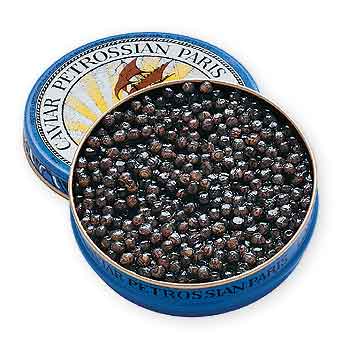 sturgeon and Stellate sturgeon were approved for export from Azerbaijan, Bulgaria, Iran, Kazakhstan, Russia and Turkmenistan—quotas that are 15 percent lower than 2005 figures. Recognizing that their sturgeon stocks in the Black Sea and lower Danube River have been seriously depleted, Bulgaria, Romania, Serbia and the Ukraine requested zero quotas for this year. Caspian border states have an additional month to provide information before a final decision is made. Caviar Emptor, a campaign of the Pew Institute for Ocean Science, SeaWeb and the Natural Resources Defense Council, urged CITES to keep the beluga caviar trade closed for another year in order to give the beluga sturgeon (Huso Huso) a chance to recover. Since the dissolution of the Soviet Union and the absence of official Soviet patrolling of the waters, illegal poaching of sturgeon has grown to an all-time high. However, ensuring that sturgeon stocks recover to safe levels will take decades of careful fisheries management and a massive initiative against poaching and illegal trade. CITES feels that the income earned from the sale of sturgeon products in 2007 should provide both an incentive and the means to pursue the long-term recovery of the sturgeon. sturgeon and Stellate sturgeon were approved for export from Azerbaijan, Bulgaria, Iran, Kazakhstan, Russia and Turkmenistan—quotas that are 15 percent lower than 2005 figures. Recognizing that their sturgeon stocks in the Black Sea and lower Danube River have been seriously depleted, Bulgaria, Romania, Serbia and the Ukraine requested zero quotas for this year. Caspian border states have an additional month to provide information before a final decision is made. Caviar Emptor, a campaign of the Pew Institute for Ocean Science, SeaWeb and the Natural Resources Defense Council, urged CITES to keep the beluga caviar trade closed for another year in order to give the beluga sturgeon (Huso Huso) a chance to recover. Since the dissolution of the Soviet Union and the absence of official Soviet patrolling of the waters, illegal poaching of sturgeon has grown to an all-time high. However, ensuring that sturgeon stocks recover to safe levels will take decades of careful fisheries management and a massive initiative against poaching and illegal trade. CITES feels that the income earned from the sale of sturgeon products in 2007 should provide both an incentive and the means to pursue the long-term recovery of the sturgeon.
Photo of caviar courtesy of Petrossian.com.
Coke Challenges Pepsi Over Coffee. Can’t make coffee? Can’t make it to Starbucks? Grab a Starbucks bottled Frappuccino and drink it cold. Frappuccinos and 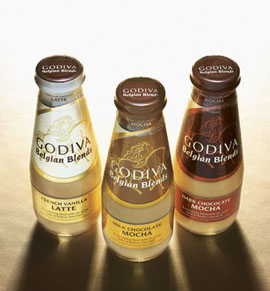 other packaged drinks dominate the market through Starbucks’ production arrangement with Pepsi. Now, Pepsi rival Coca-Cola has struck a deal with the country’s Number 2 coffeehouse chain, Caribou Coffee Co., to introduce a ready-to-drink Caribou iced coffee drink this summer. Caribou has more than 400 coffeehouses, mostly in the Midwest and Southeast. Coke also hopes to move the coffee-and-chocolate-flavored Godiva Belgian Blends it produces in partnership with Godiva, into national distribution. Meanwhile, Starbucks/Pepsi is preparing to roll out a hot coffee vending machine, which will dispense 9-ounce steel cans of hot Starbucks. The labels are insulated and the cans are recyclable. other packaged drinks dominate the market through Starbucks’ production arrangement with Pepsi. Now, Pepsi rival Coca-Cola has struck a deal with the country’s Number 2 coffeehouse chain, Caribou Coffee Co., to introduce a ready-to-drink Caribou iced coffee drink this summer. Caribou has more than 400 coffeehouses, mostly in the Midwest and Southeast. Coke also hopes to move the coffee-and-chocolate-flavored Godiva Belgian Blends it produces in partnership with Godiva, into national distribution. Meanwhile, Starbucks/Pepsi is preparing to roll out a hot coffee vending machine, which will dispense 9-ounce steel cans of hot Starbucks. The labels are insulated and the cans are recyclable.
Warm Weather Jeopardizes Ice Wine Harvest. The mild winter weather to-date is jeopardizing the potential ice wine harvest in the northeastern U.S. and Canada. To 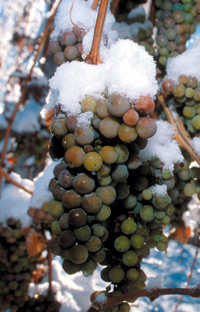 make the sweet, dessert-style wine, grapes are left on the vine long past normal harvest with the hopes that the frost will freeze the grapes so they can be pressed while frozen. Freezing concentrates the natural sweetness and acidity of the grapes, as does the added time the grapes spend on the vine, and produces a delicious and expensive wine with honey nuances—often $80 or more for a half-bottle. In the past, vintners would freeze the grapes artificially if nature did not help, but federal regulations now require the grapes to be harvested and pressed while frozen (stricter Canadian standards that many growers follow call for temperatures below 17 degrees Fahrenheit). There will be no ice wine next year if January isn’t icy-old. Grapes for most other wines in the northeastern U.S. and Canada are harvested in September and October. Ice wine grapes are usually harvested in December, often in the middle of the night before the warmth of the sun can thaw the fruit. The origins of ice wine can be traced back to the late 1700s in Franconia, Germany, where “eiswein” was discovered after an early freeze. One frozen grape yields just a few drops of rich, sugary juice, and it takes four times as many grapes to produce a bottle of ice wine—hence the higher prices. make the sweet, dessert-style wine, grapes are left on the vine long past normal harvest with the hopes that the frost will freeze the grapes so they can be pressed while frozen. Freezing concentrates the natural sweetness and acidity of the grapes, as does the added time the grapes spend on the vine, and produces a delicious and expensive wine with honey nuances—often $80 or more for a half-bottle. In the past, vintners would freeze the grapes artificially if nature did not help, but federal regulations now require the grapes to be harvested and pressed while frozen (stricter Canadian standards that many growers follow call for temperatures below 17 degrees Fahrenheit). There will be no ice wine next year if January isn’t icy-old. Grapes for most other wines in the northeastern U.S. and Canada are harvested in September and October. Ice wine grapes are usually harvested in December, often in the middle of the night before the warmth of the sun can thaw the fruit. The origins of ice wine can be traced back to the late 1700s in Franconia, Germany, where “eiswein” was discovered after an early freeze. One frozen grape yields just a few drops of rich, sugary juice, and it takes four times as many grapes to produce a bottle of ice wine—hence the higher prices.
Product Watch
Bear Naked Introduces New Granola Flavors. Bear Naked, creator of the “designer granola” market, has launched two new flavors: Peanut Butter and Jelly 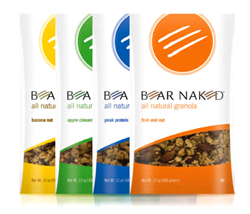 granola, which is said to strongly resemble the flavors of the sandwich (and thus has strong kid appeal), and Peak Protein Blueberry Walnut, which promises the taste and aroma of fresh-baked blueberry muffins and includes soy protein, real blueberries and walnuts. The new flavors join Apple Cinnamon, Banana Nut, Fruit and Nut and Peak Protein. All-natural Bear Naked granolas are made from whole grain oats, real dried fruit and whole nuts. The cereals are available at supermarkets and natural products stores nationwide and also are available for purchase online at BearNaked.com. Suggested retail price is $4.99 for a 12-ounce bag. granola, which is said to strongly resemble the flavors of the sandwich (and thus has strong kid appeal), and Peak Protein Blueberry Walnut, which promises the taste and aroma of fresh-baked blueberry muffins and includes soy protein, real blueberries and walnuts. The new flavors join Apple Cinnamon, Banana Nut, Fruit and Nut and Peak Protein. All-natural Bear Naked granolas are made from whole grain oats, real dried fruit and whole nuts. The cereals are available at supermarkets and natural products stores nationwide and also are available for purchase online at BearNaked.com. Suggested retail price is $4.99 for a 12-ounce bag.
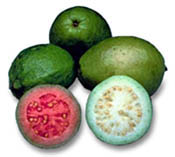 Trends Trends
More 2007 Flavor Predictions. Givaudan Flavours, a world leader in the flavors and fragrances industry, predicts guava (photo at right) and miso as the major new directions for 2007. On the horizon are açai berry, Amazonian herbs, blue ginger/galangal, mangosteen, pink peppercorn, rhubarb, rooibos/red tea and smoked paprika.

1.1.07
News
The Meatrix II 1/2. Sustainable Table, a not-for-profit organization that supports the environment through the sustainable food movement, has unveiled a major re-design  of its website, www.sustainabletable.org, offering the latest sustainability news, educational resources, shopping resources and the Sustainable Kitchen, which includes recipes and cookbook reviews. Also new is the re-launched Eat Well Guide, www.eatwellguide.org, an online directory of sustainable food outlets—restaurants, caterers, personal chefs, stores, butchers, bakers, farms etc. that abide by sustainable principles. There’s also a new Meatrix movie, The Meatrix II ½, at www.moremeatrix.com. Moorpheus gets captured by Mr. Smith and taken to a meat-packing plant for “processing.” Will he be saved in time by Leo and Henity? Read our reviews of the Meatrix movies, and be sure to start with the first two—entertaining and compelling for adults and middle school or older students who care about animals and the issues surrounding our food chain. of its website, www.sustainabletable.org, offering the latest sustainability news, educational resources, shopping resources and the Sustainable Kitchen, which includes recipes and cookbook reviews. Also new is the re-launched Eat Well Guide, www.eatwellguide.org, an online directory of sustainable food outlets—restaurants, caterers, personal chefs, stores, butchers, bakers, farms etc. that abide by sustainable principles. There’s also a new Meatrix movie, The Meatrix II ½, at www.moremeatrix.com. Moorpheus gets captured by Mr. Smith and taken to a meat-packing plant for “processing.” Will he be saved in time by Leo and Henity? Read our reviews of the Meatrix movies, and be sure to start with the first two—entertaining and compelling for adults and middle school or older students who care about animals and the issues surrounding our food chain.

2007: Drink More Tea. Teas, both green and black, have potent anti-cancer effects against a wide range of tumors, says a new study led by the U.S. Department of Agriculture (USDA). This research adds to an ever-growing body of science behind the compounds. “These findings extend related observations on the anti-carcinogenic potential of tea ingredients and suggest that consumers may benefit more by drinking both green and black teas,” wrote lead author Mendel Friedman of the USDA. The health benefits of tea—ranging from a lower risk of certain cancers to weight loss and protection against Alzheimer’s—have been linked to the polyphenol content of the tea. The researchers report that the majority of the catechins, theaflavins, theanine and all the general tea extracts decreased the numbers of human breast, colon, hepatoma (liver) and prostate cell lines. You can read the whole study here.
Product Watch
Re-energize With Sencha Shot. Those who want to start the New Year by drinking more tea can get an extra boost from Sencha Shot, an all-natural punch of green 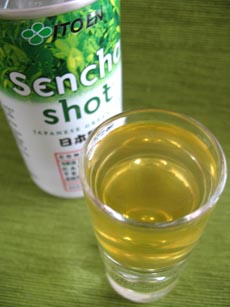 tea energy that, the company claims, fights winter doldrums and excess weight in addition to cancerous cells and cavities, among other ailments. Unlike many other green tea beverages, Sencha Shot, which is drunk cold, is an intense (and delicious) dose of green tea. The producer, Ito En, the world’s largest green tea company, uses an advanced, deep-brewing method, combining only purified water, green tea and vitamin C. We love the rich, powerful, stunning taste of Sencha Shot. The company says that many American palates need to taste it it twice to get accustomed to it the strong flavor. Not so here: with just one sip, we wanted to order it by the case! Each 6.4 fluid ounce can contains 140% of the USDA-recommended amount of Vitamin C and 152 mg of the cancer-fighting catechin, EGCG (that’s 5 times more EGCG than the average ready-to-drink green tea, according to the USDA). It has 40 mg of caffeine—less than coffee, slightly more than most sodas. The naturally-occurring amino acid theanine allows for the slow release of the caffeine and produces a calming effect rather than jittery energy. The green tea saponins work against obesity, allergies and inflammation, and fluoride strengthens teeth and bones. Read our review of calorie-free, unsweetened Sencha Shot. tea energy that, the company claims, fights winter doldrums and excess weight in addition to cancerous cells and cavities, among other ailments. Unlike many other green tea beverages, Sencha Shot, which is drunk cold, is an intense (and delicious) dose of green tea. The producer, Ito En, the world’s largest green tea company, uses an advanced, deep-brewing method, combining only purified water, green tea and vitamin C. We love the rich, powerful, stunning taste of Sencha Shot. The company says that many American palates need to taste it it twice to get accustomed to it the strong flavor. Not so here: with just one sip, we wanted to order it by the case! Each 6.4 fluid ounce can contains 140% of the USDA-recommended amount of Vitamin C and 152 mg of the cancer-fighting catechin, EGCG (that’s 5 times more EGCG than the average ready-to-drink green tea, according to the USDA). It has 40 mg of caffeine—less than coffee, slightly more than most sodas. The naturally-occurring amino acid theanine allows for the slow release of the caffeine and produces a calming effect rather than jittery energy. The green tea saponins work against obesity, allergies and inflammation, and fluoride strengthens teeth and bones. Read our review of calorie-free, unsweetened Sencha Shot.
Metromint Introduces New Flavors. Lovers of Metromint’s Peppermint- and 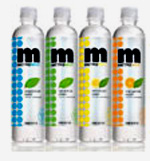 Spearmint-flavored waters (we count ourselves among them) can add Lemonmint and Orangemint to their shopping lists. The new citrus-mint varieties are, like their siblings, made with pure water, filtered for extra crispness, and flavored with fresh mint grown in Washington’s Yakima Valley. The waters have no sweeteners and are calorie-free. They’re very refreshing and a great help for New Year’s resolutions to lose weight and drink more water. Read our review of Metromint mint-flavored waters. Spearmint-flavored waters (we count ourselves among them) can add Lemonmint and Orangemint to their shopping lists. The new citrus-mint varieties are, like their siblings, made with pure water, filtered for extra crispness, and flavored with fresh mint grown in Washington’s Yakima Valley. The waters have no sweeteners and are calorie-free. They’re very refreshing and a great help for New Year’s resolutions to lose weight and drink more water. Read our review of Metromint mint-flavored waters.
Trends
Healthier Eating Includes Organics. Eating at home leads to healthier eating, according to a recent survey released by the Food Marketing Institute (FMI) and Prevention magazine. According to the survey, nearly three in four shoppers (71%) believe the food they eat at home is healthier than meals consumed out. More than nine in 10 consumers prepare at least one home-cooked dinner from scratch every week, and more than half (68%) do it almost daily. Many consumers are striving to eat healthier, and are also buying more organic foods: organic food purchases increased in virtually all the major categories. In the first 6 months of 2006:
- 44% purchased organic fruits and vegetables, up from 37% in 2005
- 30% purchased organic milk or other dairy products, up from 23%
- 29% purchased organic cereals, breads or pastas, up from 25%
- 24% purchased organic meats or poultry, up from 17%
- 24% purchased organic packaged foods (e.g., snacks and beverages), up from
21%
- 21% purchased organic eggs, up from 18%
- 16% purchased organic soups and sauces, up from 12%
The appeal of organic foods remains the perceived nutrition value, cited by 80 percent of shoppers. Nearly two-thirds mentioned long-term health effects. More than half listed the environmental impact of growing or producing these foods. The report surveyed 1,000 adults responsible for their household’s grocery shopping. THE NIBBLE’s comment: egg-lovers should try organic eggs. We find the flavor generally superior to non-organic varieties and worth the higher price. Freshness counts, too: whether organic or non-organic, the difference between a week-old egg and a three-week egg makes a huge difference (in baking as well).
What Will You See More Of In 2007? According to futurists Marian Salzman, 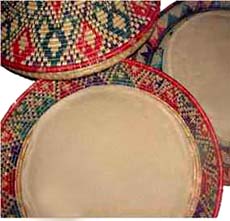 executive vice president, chief marketing officer of JWT Worldwide, and Ira Matathia, co-founder of brand consultancy NoFormula, global delicacies will continue to spread to America’s tables. Foods unfamiliar to most American shoppers that have potential to become everyday foods include Greek yogurt, jicama from Mexico, Japanese sushi rice, Portuguese peri-peri sauces and African specialties like injera, the soft Ethiopian bread that also serves as an eating utensil*. Greek yogurt is triple-strained, thicker and sweeter—more like sour cream than tangy American-style yogurt. Read about our favorite yogurt, FAGE Total Greek yogurt, which comes in 0% fat, 2% and whole milk. The 0% fat is delicious and low-calorie: just 120 calories a cup. Plain, flavored with herbs or artificial sweetener, or added to recipes, it’s one of the “diet” specialty foods we eat every day. executive vice president, chief marketing officer of JWT Worldwide, and Ira Matathia, co-founder of brand consultancy NoFormula, global delicacies will continue to spread to America’s tables. Foods unfamiliar to most American shoppers that have potential to become everyday foods include Greek yogurt, jicama from Mexico, Japanese sushi rice, Portuguese peri-peri sauces and African specialties like injera, the soft Ethiopian bread that also serves as an eating utensil*. Greek yogurt is triple-strained, thicker and sweeter—more like sour cream than tangy American-style yogurt. Read about our favorite yogurt, FAGE Total Greek yogurt, which comes in 0% fat, 2% and whole milk. The 0% fat is delicious and low-calorie: just 120 calories a cup. Plain, flavored with herbs or artificial sweetener, or added to recipes, it’s one of the “diet” specialty foods we eat every day.
*Injera, the soft, flat bread shown in the photo above, is the staple food of Ethiopia. It serves as both a plate and an eating utensil: food is heaped upon it, and pieces of the bread containing the meat and vegetables are torn off and eaten. Injera is primarily made from tef, a high-nutrition grain that contains two to three times the iron of wheat or barley and calcium, potassium and other essential minerals that also are much higher than other grains. To learn more about African products, visit AfricanMarket.com.

News Archives
| |
4th Quarter 2006 |
3rd Quarter 2006 |
| |
|
|
| 2nd Quarter 2006 |
1st Quarter 2006 |
4th Quarter 2005 |
|
|
|
| 3rd Quarter 2005 |
2nd Quarter 2005 |
1st Quarter 2005 |
|
|
|
Send your product news to:
Info at TheNibble. com.
Substitute @ for <at> and use TheNibble.com with no space. We use this convention to avoid address-harvesting spam spiders.
Don’t Miss The News:
Subscribe To Our Gourmet News & Views News Feed
Lifestyle Direct Direct, Inc. All rights reserved. Images are the copyright of their respective owners.

|




 This delicious cookie, handmade from RollingPinProductions.com, can be enjoyed with a cold glass of milk or hot chocolate. It makes a great party favor. See other
This delicious cookie, handmade from RollingPinProductions.com, can be enjoyed with a cold glass of milk or hot chocolate. It makes a great party favor. See other 
 annual Toast of the Town extravaganza—more than 500 wines and spirits and foods from 30 top restaurants. The dates are San Francisco on Thursday, March 29, New York on April 23, and Chicago on May 3. VIP ticket holders ($185) can begin tasting and feasting at 5 p.m., regular ticket holders ($95) can celebrate from 7 p.m. to 10 p.m. Click here for
annual Toast of the Town extravaganza—more than 500 wines and spirits and foods from 30 top restaurants. The dates are San Francisco on Thursday, March 29, New York on April 23, and Chicago on May 3. VIP ticket holders ($185) can begin tasting and feasting at 5 p.m., regular ticket holders ($95) can celebrate from 7 p.m. to 10 p.m. Click here for  from a bagel or donut. Robert Bohannon, a molecular scientist from Durham, North Carolina, has developed a way to add caffeine to baked goods and is now pitching the concept to chains including Krispy Kreme, Starbucks and Dunkin’ Donuts. He solved the challenge of masking the bitterness of caffeine so it can be used in food and pastry products, and Buzz Donuts and Buzzed Bagels are ready to go.
from a bagel or donut. Robert Bohannon, a molecular scientist from Durham, North Carolina, has developed a way to add caffeine to baked goods and is now pitching the concept to chains including Krispy Kreme, Starbucks and Dunkin’ Donuts. He solved the challenge of masking the bitterness of caffeine so it can be used in food and pastry products, and Buzz Donuts and Buzzed Bagels are ready to go.  benefits of probiotics are due, in large part, to the effects of these so-called "friendly" bacteria on different intestinal functions and are strain-specific. Depending on the specific strain of probiotic culture in each product, benefits associated with immune function, gastrointestinal function and oral health can be realized. Note that yogurt with active cultures that are beneficial to the digestive system have been available for some time: probiotics are part of the functional foods movement, where products have an added function beyond the basic nutrition. DanActive, launching nationwide this month, is a cultured probiotic dairy drink that has been clinically proven to help naturally strengthen the body’s defenses when consumed daily. It contains the proprietary probiotic L. casei Immunitas culture, clinically proven to work in the digestive track, where 70 percent of a person’s immune system is located. It was introduced in Europe in 1994 and later in Asia under the brand name Actimel. The existing Danimals line of lowfat yogurt cups and drinks made for children has been reformulated to contain no artificial colors, no artificial flavors and no high fructose corn syrup—and will include Lactobacillus GG (LGG), which has been clinically proven to have positive effects on gastrointestinal function, the function of the immune system and the maintenance of oral health.
benefits of probiotics are due, in large part, to the effects of these so-called "friendly" bacteria on different intestinal functions and are strain-specific. Depending on the specific strain of probiotic culture in each product, benefits associated with immune function, gastrointestinal function and oral health can be realized. Note that yogurt with active cultures that are beneficial to the digestive system have been available for some time: probiotics are part of the functional foods movement, where products have an added function beyond the basic nutrition. DanActive, launching nationwide this month, is a cultured probiotic dairy drink that has been clinically proven to help naturally strengthen the body’s defenses when consumed daily. It contains the proprietary probiotic L. casei Immunitas culture, clinically proven to work in the digestive track, where 70 percent of a person’s immune system is located. It was introduced in Europe in 1994 and later in Asia under the brand name Actimel. The existing Danimals line of lowfat yogurt cups and drinks made for children has been reformulated to contain no artificial colors, no artificial flavors and no high fructose corn syrup—and will include Lactobacillus GG (LGG), which has been clinically proven to have positive effects on gastrointestinal function, the function of the immune system and the maintenance of oral health.  to maintain the shade plantations and an adjacent Cerulean Warbler forest reserve. By purchasing this premium coffee, those who care about the environment can help traditional coffee cooperatives maintain shade plantations, preserving habitats for the Cerulean Warbler and other migratory songbirds. Shade grown coffee plantations are at risk of being converted to sun coffee and other cash crops, resulting in a loss of forest cover and bird habitat. The loss of these plantations is cited as a reason for the bird’s decline. The coffee can be ordered from abcbirds.org. Paul Katzeff, roastmaster for Thanksgiving Coffee, describes the coffee as “the best Colombian coffee I have tasted, and I have been roasting coffee since 1969.” He extols its “heavy body, silky smooth notes of cashew and apricot, and a long fruity finish. If you like coffee ice cream, you will love this classic Colombian Coffee.” Learn more about the plight of songbirds,
to maintain the shade plantations and an adjacent Cerulean Warbler forest reserve. By purchasing this premium coffee, those who care about the environment can help traditional coffee cooperatives maintain shade plantations, preserving habitats for the Cerulean Warbler and other migratory songbirds. Shade grown coffee plantations are at risk of being converted to sun coffee and other cash crops, resulting in a loss of forest cover and bird habitat. The loss of these plantations is cited as a reason for the bird’s decline. The coffee can be ordered from abcbirds.org. Paul Katzeff, roastmaster for Thanksgiving Coffee, describes the coffee as “the best Colombian coffee I have tasted, and I have been roasting coffee since 1969.” He extols its “heavy body, silky smooth notes of cashew and apricot, and a long fruity finish. If you like coffee ice cream, you will love this classic Colombian Coffee.” Learn more about the plight of songbirds,  to.” Culprits include Yoplait’s Strawberry Splash Go-Gurt Yogurt which does not contain any actual fruit, and Berry Berry Kix, which, despite fruit images and reference to “natural fruit flavors,” contains no fruit. Only 27% of the products examined contained fruit (in the form of fruit purée or fruit from concentrate). Six percent were 100% fruit juice; however fruit juice does not contain the equivalent fiber, vitamins and minerals of whole fruit. Dr. Andria Ruth, a pediatrician for the Diabetes Resource Center of Santa Barbara, commented that “these food companies are making parents’ jobs even harder by using misleading packaging to lead them to think that they are making a healthy choice when they are not.” To support healthy eating habits, the Strategic Alliance is calling on food manufacturers to stop marketing children’s food products as something that they are not and to begin providing more nutritious food options. The Strategic Alliance for Healthy Food and Activity Environments is a coalition of California’s leading public health and health care, parks and recreation, transportation and nutrition organizations committed to promoting environmental and policy changes to support healthy eating and physical activity.
to.” Culprits include Yoplait’s Strawberry Splash Go-Gurt Yogurt which does not contain any actual fruit, and Berry Berry Kix, which, despite fruit images and reference to “natural fruit flavors,” contains no fruit. Only 27% of the products examined contained fruit (in the form of fruit purée or fruit from concentrate). Six percent were 100% fruit juice; however fruit juice does not contain the equivalent fiber, vitamins and minerals of whole fruit. Dr. Andria Ruth, a pediatrician for the Diabetes Resource Center of Santa Barbara, commented that “these food companies are making parents’ jobs even harder by using misleading packaging to lead them to think that they are making a healthy choice when they are not.” To support healthy eating habits, the Strategic Alliance is calling on food manufacturers to stop marketing children’s food products as something that they are not and to begin providing more nutritious food options. The Strategic Alliance for Healthy Food and Activity Environments is a coalition of California’s leading public health and health care, parks and recreation, transportation and nutrition organizations committed to promoting environmental and policy changes to support healthy eating and physical activity. men—with something fun and gimmicky. Spykes is a fruity beer additive, a malt liquor with a 12% alcohol content that can be mixed or taken as a shot, and is slightly caffeinated, for a kick. Packaged in 2-ounce bottles, sold for up to $2.00 per bottle, Spykes is available in Spicy Mango, Spicy Lime, Hot Melon and Hot Chocolate (all of the flavors have a slight, jalapeño-like burn on the finish). The bottles can be tossed into one’s purse or pocket and can be mixed with just about anything, including gin and vodka—although Anheuser Bush hopes the flavor spikes will encourage more beer sales, since beer makers have been losing market share to distilled spirits for the last five years. The Belgians love their fruit lambics, and Americans have been squeezing fresh lime wedges into longneck Coronas for decades. Perhaps Spykes will spark a new generation of beer-lovers.
men—with something fun and gimmicky. Spykes is a fruity beer additive, a malt liquor with a 12% alcohol content that can be mixed or taken as a shot, and is slightly caffeinated, for a kick. Packaged in 2-ounce bottles, sold for up to $2.00 per bottle, Spykes is available in Spicy Mango, Spicy Lime, Hot Melon and Hot Chocolate (all of the flavors have a slight, jalapeño-like burn on the finish). The bottles can be tossed into one’s purse or pocket and can be mixed with just about anything, including gin and vodka—although Anheuser Bush hopes the flavor spikes will encourage more beer sales, since beer makers have been losing market share to distilled spirits for the last five years. The Belgians love their fruit lambics, and Americans have been squeezing fresh lime wedges into longneck Coronas for decades. Perhaps Spykes will spark a new generation of beer-lovers. vodka called p.i.n.k., a huckleberry-flavored vodka called 44° North (the latitude of the distillery), and Zodiac, which comes in 12 different bottles, one for each zodiac sign. An entrepreneur in the Florida Keys came up with the idea for a Key lime vodka. A New York entrepreneur launched Hamptons Vodka, hoping to grab the cachet of the tony leisure spot. Hundreds more ideas proliferate, but will never make it to the shelf. So far, the proliferation of new niche vodkas has had only a negligible impact on sales of the big brands such as Smirnoff and Stolichnaya, which sell millions of cases a year. Small vodka producers, in contrast, often sell no more than a few thousand. But big companies are taking note of the trend, launching their own niche products, and, in rare instances, buying smaller brands. If you’re dying to have your own vodka brand, you can do it without investing millions. For for $15,000, Modern Spirits of California will guide you to produce 10 cases of your own superpremium vodka. Click for more information about
vodka called p.i.n.k., a huckleberry-flavored vodka called 44° North (the latitude of the distillery), and Zodiac, which comes in 12 different bottles, one for each zodiac sign. An entrepreneur in the Florida Keys came up with the idea for a Key lime vodka. A New York entrepreneur launched Hamptons Vodka, hoping to grab the cachet of the tony leisure spot. Hundreds more ideas proliferate, but will never make it to the shelf. So far, the proliferation of new niche vodkas has had only a negligible impact on sales of the big brands such as Smirnoff and Stolichnaya, which sell millions of cases a year. Small vodka producers, in contrast, often sell no more than a few thousand. But big companies are taking note of the trend, launching their own niche products, and, in rare instances, buying smaller brands. If you’re dying to have your own vodka brand, you can do it without investing millions. For for $15,000, Modern Spirits of California will guide you to produce 10 cases of your own superpremium vodka. Click for more information about  Chili Lime, but the Jamaican jerk spice won out. Jerk spice is a smoky-sweet combination of chili pepper, black pepper, cinnamon, allspice, cumin and thyme. Left in the dust were Aztec Chocolate and Royal Indian Curry. It was not necessary to taste the chips, so many people may have voted on the concept idea. We at THE NIBBLE liked all of the flavors (Aztec Chocolate is a great chip flavor), but the consensus was that Island Jerk was the best “food chip”: i.e., it fit in the best with sandwiches, burgers, etc. You can still taste them all (and we highly recommend it): a limited number of Party Packs containing all five-ounce bags of each flavor flavors are still available and can be purchased online. The cost is $19.95 each, or two for $32.95, including shipping. The Party pack includes “A Taste of Putumayo: Music for Every Palate” music sampler CD and materials for throwing a chip-tasting party. The Island Jerk chip will be in the stores by summer. This is the first year that Kettle did not declare a tie winner. Past People's Choice winners include Buffalo Bleu, Cheddar Beer™, Spicy Thai™ and Tuscan Three Cheese.
Chili Lime, but the Jamaican jerk spice won out. Jerk spice is a smoky-sweet combination of chili pepper, black pepper, cinnamon, allspice, cumin and thyme. Left in the dust were Aztec Chocolate and Royal Indian Curry. It was not necessary to taste the chips, so many people may have voted on the concept idea. We at THE NIBBLE liked all of the flavors (Aztec Chocolate is a great chip flavor), but the consensus was that Island Jerk was the best “food chip”: i.e., it fit in the best with sandwiches, burgers, etc. You can still taste them all (and we highly recommend it): a limited number of Party Packs containing all five-ounce bags of each flavor flavors are still available and can be purchased online. The cost is $19.95 each, or two for $32.95, including shipping. The Party pack includes “A Taste of Putumayo: Music for Every Palate” music sampler CD and materials for throwing a chip-tasting party. The Island Jerk chip will be in the stores by summer. This is the first year that Kettle did not declare a tie winner. Past People's Choice winners include Buffalo Bleu, Cheddar Beer™, Spicy Thai™ and Tuscan Three Cheese.  cereal bar/theme restaurant established in 2003 at Arizona State University, has been slinging cereal to great success beyond university campuses. Office workers love it, travelers love it too. The company has opened two stands at a Newark Liberty Airport, and will open a Cereality Express next month, followed shortly by one at JFK Airport in New York, and then a full 200-square-foot kiosk at O’Hare International Airport by late winter. Cereal isn’t just for early-morning travelers: while it is still primarily thought of as a breakfast food, it is also seen as nutritious and a comfort food. Given the choice of food available at airports, a bowl of Cheerios® or oatmeal with milk and bananas will often sound like a better option, regardless of the time of day. The Cereality concept allows customers to choose customized oatmeal or cold cereal concoctions with choices of nostalgic cereals such as Quisp, mix-ins, toppings and flavored milk for $4.
cereal bar/theme restaurant established in 2003 at Arizona State University, has been slinging cereal to great success beyond university campuses. Office workers love it, travelers love it too. The company has opened two stands at a Newark Liberty Airport, and will open a Cereality Express next month, followed shortly by one at JFK Airport in New York, and then a full 200-square-foot kiosk at O’Hare International Airport by late winter. Cereal isn’t just for early-morning travelers: while it is still primarily thought of as a breakfast food, it is also seen as nutritious and a comfort food. Given the choice of food available at airports, a bowl of Cheerios® or oatmeal with milk and bananas will often sound like a better option, regardless of the time of day. The Cereality concept allows customers to choose customized oatmeal or cold cereal concoctions with choices of nostalgic cereals such as Quisp, mix-ins, toppings and flavored milk for $4.  Have A Guinness—Toasted And Buttered.
Have A Guinness—Toasted And Buttered. varietal peppercorns. Pepper has been the world’s most popular spice for more than a thousand years (salt isn’t a spice, which is defined as the dried seeds, buds, fruit, bark, roots or flower parts of plants). Originally from southeast India, you now can buy peppercorns from Ecuador, Indonesia, Malaysia and Vietnam—and use them to make meat crusts and ice cream as well as to grind onto prepared food. One of our recommended holiday gifts was Chef Stefan’s Epicurean Pepper Collection: twelve different peppers including Aleppo, Cubeb Berries, Grains of the Paradise, Green Peppercorns, Jamaican, Long Pepper, Malabar, Moula, Muntok, Pink Peppercorns, Sarawak White and Tellicherry. There are food pairing suggestions for each varietal (available at SaltsOfTheWorld.com). Next month, THE NIBBLE will delve into the topic of varietal peppercorns in spicy detail.
varietal peppercorns. Pepper has been the world’s most popular spice for more than a thousand years (salt isn’t a spice, which is defined as the dried seeds, buds, fruit, bark, roots or flower parts of plants). Originally from southeast India, you now can buy peppercorns from Ecuador, Indonesia, Malaysia and Vietnam—and use them to make meat crusts and ice cream as well as to grind onto prepared food. One of our recommended holiday gifts was Chef Stefan’s Epicurean Pepper Collection: twelve different peppers including Aleppo, Cubeb Berries, Grains of the Paradise, Green Peppercorns, Jamaican, Long Pepper, Malabar, Moula, Muntok, Pink Peppercorns, Sarawak White and Tellicherry. There are food pairing suggestions for each varietal (available at SaltsOfTheWorld.com). Next month, THE NIBBLE will delve into the topic of varietal peppercorns in spicy detail.  were only orange-flavored seltzers. We loved the natural orange flavor in Volvic’s crisp spring water. The product has re-emerged sweetened, with 14g of sugar in a 500 ml (1.05 pint) bottle. We personally don’t care for the whole Fruitwater concept of flavored, sweetened waters—we prefer our water flavored but without the sugar, and we loved the product as Glaceau originally made it, as unsweetened, fruit-flavored water. But, cater to the soda-drenched American palate, and you can get Americans to drink “water” as long as you don’t carbonate it (NB: soda is flavored, sweetened, carbonated water). Volvic, a French water company does it better than the Americans. The two Volvic flavors start with a better-quality water, and have a very different flavor profile: they taste like dilute orange juice and dilute lemonade, respectively. If you love your orange juice or your lemonade, think of them as lower-calorie spa versions. Available at fine food stores or at Volvic-na.com. If it hurts you to give up your O.J. when you’re on a diet, at 30 calories for 8 ounces, we endorse Volvic Natural Orange and Natural Lemon.
were only orange-flavored seltzers. We loved the natural orange flavor in Volvic’s crisp spring water. The product has re-emerged sweetened, with 14g of sugar in a 500 ml (1.05 pint) bottle. We personally don’t care for the whole Fruitwater concept of flavored, sweetened waters—we prefer our water flavored but without the sugar, and we loved the product as Glaceau originally made it, as unsweetened, fruit-flavored water. But, cater to the soda-drenched American palate, and you can get Americans to drink “water” as long as you don’t carbonate it (NB: soda is flavored, sweetened, carbonated water). Volvic, a French water company does it better than the Americans. The two Volvic flavors start with a better-quality water, and have a very different flavor profile: they taste like dilute orange juice and dilute lemonade, respectively. If you love your orange juice or your lemonade, think of them as lower-calorie spa versions. Available at fine food stores or at Volvic-na.com. If it hurts you to give up your O.J. when you’re on a diet, at 30 calories for 8 ounces, we endorse Volvic Natural Orange and Natural Lemon.  stroke, new research has found that adding milk negates those benefits. According to researchers at the Charite Hospital at the University of Berlin, Germany, the casein (protein) in milk interacts with tea, decreasing the concentration of catechin, the flavonoids in tea that protect against heart disease. The beneficial effects of drinking black tea are completely prevented by the addition of milk, said Dr. Verena Stangl, a cardiologist at the hospital. “If you want to drink tea to have the beneficial health effects, you have to drink it without milk. That is clearly shown by our experiments,” she told Reuters. The findings, reported in the European Heart Journal, could explain why countries such as Great Britain, where tea is regularly consumed with milk, have not shown a decreased risk of heart disease and stroke from drinking tea, whereas Asian countries, which do not consume milk with tea, show the benefit.
stroke, new research has found that adding milk negates those benefits. According to researchers at the Charite Hospital at the University of Berlin, Germany, the casein (protein) in milk interacts with tea, decreasing the concentration of catechin, the flavonoids in tea that protect against heart disease. The beneficial effects of drinking black tea are completely prevented by the addition of milk, said Dr. Verena Stangl, a cardiologist at the hospital. “If you want to drink tea to have the beneficial health effects, you have to drink it without milk. That is clearly shown by our experiments,” she told Reuters. The findings, reported in the European Heart Journal, could explain why countries such as Great Britain, where tea is regularly consumed with milk, have not shown a decreased risk of heart disease and stroke from drinking tea, whereas Asian countries, which do not consume milk with tea, show the benefit.  anniversary of Hershey’s Kisses, a colorful new stamp featuring a Hershey’s Kisses chocolate and a big red heart was issued last week. The iconic shape of Kisses has not changed since The Hershey Company introduced the milk-chocolate candies in 1907 (they were wrapped by hand until the process was automated in 1921). Kisses have been available year-round since their debut, except from 1942 to 1949, when silver foil was rationed during World War II. Kisses chocolates wrapped in red and silver foil were introduced in 1986 in honor of Valentine’s Day, and they now can be found in a variety of seasonal colors. The Postal Service began issuing its popular Love stamps in 1973. Over the years the stamps have featured a delightful assortment of designs including heart motifs, colorful flowers and the word “LOVE" itself.” They’re popular for wedding and engagement invitations, so if you have plans, stock up.
anniversary of Hershey’s Kisses, a colorful new stamp featuring a Hershey’s Kisses chocolate and a big red heart was issued last week. The iconic shape of Kisses has not changed since The Hershey Company introduced the milk-chocolate candies in 1907 (they were wrapped by hand until the process was automated in 1921). Kisses have been available year-round since their debut, except from 1942 to 1949, when silver foil was rationed during World War II. Kisses chocolates wrapped in red and silver foil were introduced in 1986 in honor of Valentine’s Day, and they now can be found in a variety of seasonal colors. The Postal Service began issuing its popular Love stamps in 1973. Over the years the stamps have featured a delightful assortment of designs including heart motifs, colorful flowers and the word “LOVE" itself.” They’re popular for wedding and engagement invitations, so if you have plans, stock up.  it the “silliest” ordinance the City Council has ever passed. Many restaurants have simply continued to serve foie gras to please their clientele: While the city ordinance bans the sale of foie gras, establishments can give it away—for example, by selling a salad with a complimentary side of foie gras, or by including it as a free course “courtesy of management” with a tasting dinner. While there have been only a handful of complaints about non-compliance, the Health Department has no time to pursue any violations, needing to focus its time on protecting the public from situations that actually are harmful. “Our mission is to protect human health and not the health of geese and ducks,” said Health Department spokesman Tim Hadac, who called the ban the department’s lowest priority. Even Alderman Joe Moore, who sponsored the legislation, has said that he realizes the Health Department has more pressing issues. As other cities, under pressure from animal activist groups, are forced to consider legislation, Chicago will hopefully stand as an example that time can be put to better use. We at THE NIBBLE have previously commented that it is easy for activists to pick on a tiny, unorganized industry like foie gras, which impacts very few animals because the food is eaten by so few people. The activists feel that geese are overfed in a cruel fashion. If they wish to truly help animals, why not pursue a significant issue, such as the fact that many millions of lobsters and crabs are plunged live into boiling water each year? Because it is much easier and safer to make an issue of an animal that few people are familiar with or want to eat, than try to deprive Americans of their lobsters. Foie gras activists have also damaged private property to make their views “heard,” breaking into and defacing facilities where foie gras is produced and sold. Whatever your personal views on foie gras, this has not been an admirable example of people campaigning for positive change.
it the “silliest” ordinance the City Council has ever passed. Many restaurants have simply continued to serve foie gras to please their clientele: While the city ordinance bans the sale of foie gras, establishments can give it away—for example, by selling a salad with a complimentary side of foie gras, or by including it as a free course “courtesy of management” with a tasting dinner. While there have been only a handful of complaints about non-compliance, the Health Department has no time to pursue any violations, needing to focus its time on protecting the public from situations that actually are harmful. “Our mission is to protect human health and not the health of geese and ducks,” said Health Department spokesman Tim Hadac, who called the ban the department’s lowest priority. Even Alderman Joe Moore, who sponsored the legislation, has said that he realizes the Health Department has more pressing issues. As other cities, under pressure from animal activist groups, are forced to consider legislation, Chicago will hopefully stand as an example that time can be put to better use. We at THE NIBBLE have previously commented that it is easy for activists to pick on a tiny, unorganized industry like foie gras, which impacts very few animals because the food is eaten by so few people. The activists feel that geese are overfed in a cruel fashion. If they wish to truly help animals, why not pursue a significant issue, such as the fact that many millions of lobsters and crabs are plunged live into boiling water each year? Because it is much easier and safer to make an issue of an animal that few people are familiar with or want to eat, than try to deprive Americans of their lobsters. Foie gras activists have also damaged private property to make their views “heard,” breaking into and defacing facilities where foie gras is produced and sold. Whatever your personal views on foie gras, this has not been an admirable example of people campaigning for positive change. Coca-Cola Company and Nestlé that focuses on black teas and Enviga, a sparkling green tea beverage that has launched in Europe, is headed to the U.S., and is proven to burn calories (although not at any significant rate to engender weight loss). While the website is a bit overproduced by designers who think others have nothing else to do with their time but wait for fancy pages to load, there’s a a heavy lifestyle story going on at GoldPeakTea.com, complete with a fictional town where people sit in Adirondack chairs and gaze out at an idyllic mountain lake, drinking their Gold Peak iced tea, and introducing about different characters who prefer different flavors. The Diet Iced Tea we selected was the best we’d ever had for a sweetened no-calorie product: superb, strong black tea flavor with a sweetener of aspartame and acesulfame potassium that tasted exactly like sugar. Other flavors include Sweetened, Unsweetened, Lemon and Green Tea. You can phone to find a local retailer: 1.800.488.2267. Gold Peak is certified kosher by OU.
Coca-Cola Company and Nestlé that focuses on black teas and Enviga, a sparkling green tea beverage that has launched in Europe, is headed to the U.S., and is proven to burn calories (although not at any significant rate to engender weight loss). While the website is a bit overproduced by designers who think others have nothing else to do with their time but wait for fancy pages to load, there’s a a heavy lifestyle story going on at GoldPeakTea.com, complete with a fictional town where people sit in Adirondack chairs and gaze out at an idyllic mountain lake, drinking their Gold Peak iced tea, and introducing about different characters who prefer different flavors. The Diet Iced Tea we selected was the best we’d ever had for a sweetened no-calorie product: superb, strong black tea flavor with a sweetener of aspartame and acesulfame potassium that tasted exactly like sugar. Other flavors include Sweetened, Unsweetened, Lemon and Green Tea. You can phone to find a local retailer: 1.800.488.2267. Gold Peak is certified kosher by OU. menus at mainstream restaurants from coast to coast. In fact, the study says, these “emerging concepts” are driving the future of what could be considered a redefinition of comfort food—a combination of retro, artisan, global flavors and other markers. The trends can be seen not just at white table cloth and ethnic restaurants but at chain restaurants and on retail shelves. Products such as Fran’s Chocolates’ chocolate-covered caramels topped with Welsh smoked sea salt (milk chocolate caramels in photo at right) and Kettle Brand’s roasted red pepper with goat cheese potato chips have been successful in the market for two years. And, the study notes, the once exotic and rare portobello mushroom is now available as a portobello mushroom burger at Carl's Jr. fast food restaurants, for $6.00. Combining comfort and familiarity, restaurants are also offering gourmet Fluffernutter sandwiches, crab-stuffed tater tots and truffled macaroni and cheese. We’re waiting for Taco Bell to offer the kangaroo nachos.
menus at mainstream restaurants from coast to coast. In fact, the study says, these “emerging concepts” are driving the future of what could be considered a redefinition of comfort food—a combination of retro, artisan, global flavors and other markers. The trends can be seen not just at white table cloth and ethnic restaurants but at chain restaurants and on retail shelves. Products such as Fran’s Chocolates’ chocolate-covered caramels topped with Welsh smoked sea salt (milk chocolate caramels in photo at right) and Kettle Brand’s roasted red pepper with goat cheese potato chips have been successful in the market for two years. And, the study notes, the once exotic and rare portobello mushroom is now available as a portobello mushroom burger at Carl's Jr. fast food restaurants, for $6.00. Combining comfort and familiarity, restaurants are also offering gourmet Fluffernutter sandwiches, crab-stuffed tater tots and truffled macaroni and cheese. We’re waiting for Taco Bell to offer the kangaroo nachos. brands to pour into the U.S. market in 2007. Designer waters from glaciers, melted icebergs and ancient restored European sources will compete with waters enriched with extra molecules of oxygen and herbal essences. Given the money to be made in new water brands, drilling and development of new artesian water sources in remote regions such as the Canadian Arctic and elsewhere is underway. Designer brands from Japan, New Zealand and the Pacific islands, which offer a crisper and cleaner taste due to underlying volcanic rock formation which filters the water, are on the rise (note the success of Fiji Water). New source from areas not even associated with fine water have even join the fray: look for water from South Africa and Brazil. And of course, in the American market, provenance is secondary to packaging is king: companies are putting thought into the look and feel of their bottles to create the perfect brand image. Water bars, like wine bars, previously seen only in Los Angeles, have expanded to other cities: people can order from the water menu and pair foods that match. Each month, THE NIBBLE reviews one fine water: You can read about it in the monthly
brands to pour into the U.S. market in 2007. Designer waters from glaciers, melted icebergs and ancient restored European sources will compete with waters enriched with extra molecules of oxygen and herbal essences. Given the money to be made in new water brands, drilling and development of new artesian water sources in remote regions such as the Canadian Arctic and elsewhere is underway. Designer brands from Japan, New Zealand and the Pacific islands, which offer a crisper and cleaner taste due to underlying volcanic rock formation which filters the water, are on the rise (note the success of Fiji Water). New source from areas not even associated with fine water have even join the fray: look for water from South Africa and Brazil. And of course, in the American market, provenance is secondary to packaging is king: companies are putting thought into the look and feel of their bottles to create the perfect brand image. Water bars, like wine bars, previously seen only in Los Angeles, have expanded to other cities: people can order from the water menu and pair foods that match. Each month, THE NIBBLE reviews one fine water: You can read about it in the monthly  sturgeon and Stellate sturgeon were approved for export from Azerbaijan, Bulgaria, Iran, Kazakhstan, Russia and Turkmenistan—quotas that are 15 percent lower than 2005 figures. Recognizing that their sturgeon stocks in the Black Sea and lower Danube River have been seriously depleted, Bulgaria, Romania, Serbia and the Ukraine requested zero quotas for this year. Caspian border states have an additional month to provide information before a final decision is made. Caviar Emptor, a campaign of the Pew Institute for Ocean Science, SeaWeb and the Natural Resources Defense Council, urged CITES to keep the beluga caviar trade closed for another year in order to give the beluga sturgeon (Huso Huso) a chance to recover. Since the dissolution of the Soviet Union and the absence of official Soviet patrolling of the waters, illegal poaching of sturgeon has grown to an all-time high. However, ensuring that sturgeon stocks recover to safe levels will take decades of careful fisheries management and a massive initiative against poaching and illegal trade. CITES feels that the income earned from the sale of sturgeon products in 2007 should provide both an incentive and the means to pursue the long-term recovery of the sturgeon.
sturgeon and Stellate sturgeon were approved for export from Azerbaijan, Bulgaria, Iran, Kazakhstan, Russia and Turkmenistan—quotas that are 15 percent lower than 2005 figures. Recognizing that their sturgeon stocks in the Black Sea and lower Danube River have been seriously depleted, Bulgaria, Romania, Serbia and the Ukraine requested zero quotas for this year. Caspian border states have an additional month to provide information before a final decision is made. Caviar Emptor, a campaign of the Pew Institute for Ocean Science, SeaWeb and the Natural Resources Defense Council, urged CITES to keep the beluga caviar trade closed for another year in order to give the beluga sturgeon (Huso Huso) a chance to recover. Since the dissolution of the Soviet Union and the absence of official Soviet patrolling of the waters, illegal poaching of sturgeon has grown to an all-time high. However, ensuring that sturgeon stocks recover to safe levels will take decades of careful fisheries management and a massive initiative against poaching and illegal trade. CITES feels that the income earned from the sale of sturgeon products in 2007 should provide both an incentive and the means to pursue the long-term recovery of the sturgeon.  other packaged drinks dominate the market through Starbucks’ production arrangement with Pepsi. Now, Pepsi rival Coca-Cola has struck a deal with the country’s Number 2 coffeehouse chain, Caribou Coffee Co., to introduce a ready-to-drink Caribou iced coffee drink this summer. Caribou has more than 400 coffeehouses, mostly in the Midwest and Southeast. Coke also hopes to move the coffee-and-chocolate-flavored Godiva Belgian Blends it produces in partnership with Godiva, into national distribution. Meanwhile, Starbucks/Pepsi is preparing to roll out a hot coffee vending machine, which will dispense 9-ounce steel cans of hot Starbucks. The labels are insulated and the cans are recyclable.
other packaged drinks dominate the market through Starbucks’ production arrangement with Pepsi. Now, Pepsi rival Coca-Cola has struck a deal with the country’s Number 2 coffeehouse chain, Caribou Coffee Co., to introduce a ready-to-drink Caribou iced coffee drink this summer. Caribou has more than 400 coffeehouses, mostly in the Midwest and Southeast. Coke also hopes to move the coffee-and-chocolate-flavored Godiva Belgian Blends it produces in partnership with Godiva, into national distribution. Meanwhile, Starbucks/Pepsi is preparing to roll out a hot coffee vending machine, which will dispense 9-ounce steel cans of hot Starbucks. The labels are insulated and the cans are recyclable. make the sweet, dessert-style wine, grapes are left on the vine long past normal harvest with the hopes that the frost will freeze the grapes so they can be pressed while frozen. Freezing concentrates the natural sweetness and acidity of the grapes, as does the added time the grapes spend on the vine, and produces a delicious and expensive wine with honey nuances—often $80 or more for a half-bottle. In the past, vintners would freeze the grapes artificially if nature did not help, but federal regulations now require the grapes to be harvested and pressed while frozen (stricter Canadian standards that many growers follow call for temperatures below 17 degrees Fahrenheit). There will be no ice wine next year if January isn’t icy-old. Grapes for most other wines in the northeastern U.S. and Canada are harvested in September and October. Ice wine grapes are usually harvested in December, often in the middle of the night before the warmth of the sun can thaw the fruit. The origins of ice wine can be traced back to the late 1700s in Franconia, Germany, where “eiswein” was discovered after an early freeze. One frozen grape yields just a few drops of rich, sugary juice, and it takes four times as many grapes to produce a bottle of ice wine—hence the higher prices.
make the sweet, dessert-style wine, grapes are left on the vine long past normal harvest with the hopes that the frost will freeze the grapes so they can be pressed while frozen. Freezing concentrates the natural sweetness and acidity of the grapes, as does the added time the grapes spend on the vine, and produces a delicious and expensive wine with honey nuances—often $80 or more for a half-bottle. In the past, vintners would freeze the grapes artificially if nature did not help, but federal regulations now require the grapes to be harvested and pressed while frozen (stricter Canadian standards that many growers follow call for temperatures below 17 degrees Fahrenheit). There will be no ice wine next year if January isn’t icy-old. Grapes for most other wines in the northeastern U.S. and Canada are harvested in September and October. Ice wine grapes are usually harvested in December, often in the middle of the night before the warmth of the sun can thaw the fruit. The origins of ice wine can be traced back to the late 1700s in Franconia, Germany, where “eiswein” was discovered after an early freeze. One frozen grape yields just a few drops of rich, sugary juice, and it takes four times as many grapes to produce a bottle of ice wine—hence the higher prices. granola, which is said to strongly resemble the flavors of the sandwich (and thus has strong kid appeal), and Peak Protein Blueberry Walnut, which promises the taste and aroma of fresh-baked blueberry muffins and includes soy protein, real blueberries and walnuts. The new flavors join Apple Cinnamon, Banana Nut, Fruit and Nut and Peak Protein. All-natural Bear Naked granolas are made from whole grain oats, real dried fruit and whole nuts. The cereals are available at supermarkets and natural products stores nationwide and also are available for purchase online at BearNaked.com. Suggested retail price is $4.99 for a 12-ounce bag.
granola, which is said to strongly resemble the flavors of the sandwich (and thus has strong kid appeal), and Peak Protein Blueberry Walnut, which promises the taste and aroma of fresh-baked blueberry muffins and includes soy protein, real blueberries and walnuts. The new flavors join Apple Cinnamon, Banana Nut, Fruit and Nut and Peak Protein. All-natural Bear Naked granolas are made from whole grain oats, real dried fruit and whole nuts. The cereals are available at supermarkets and natural products stores nationwide and also are available for purchase online at BearNaked.com. Suggested retail price is $4.99 for a 12-ounce bag. 

 of its website, www.sustainabletable.org, offering the latest sustainability news, educational resources, shopping resources and the Sustainable Kitchen, which includes recipes and cookbook reviews. Also new is the re-launched Eat Well Guide, www.eatwellguide.org, an online directory of sustainable food outlets—restaurants, caterers, personal chefs, stores, butchers, bakers, farms etc. that abide by sustainable principles. There’s also a new Meatrix movie, The Meatrix II ½, at www.moremeatrix.com. Moorpheus gets captured by Mr. Smith and taken to a meat-packing plant for “processing.” Will he be saved in time by Leo and Henity? Read our
of its website, www.sustainabletable.org, offering the latest sustainability news, educational resources, shopping resources and the Sustainable Kitchen, which includes recipes and cookbook reviews. Also new is the re-launched Eat Well Guide, www.eatwellguide.org, an online directory of sustainable food outlets—restaurants, caterers, personal chefs, stores, butchers, bakers, farms etc. that abide by sustainable principles. There’s also a new Meatrix movie, The Meatrix II ½, at www.moremeatrix.com. Moorpheus gets captured by Mr. Smith and taken to a meat-packing plant for “processing.” Will he be saved in time by Leo and Henity? Read our 
 tea energy that, the company claims, fights winter doldrums and excess weight in addition to cancerous cells and cavities, among other ailments. Unlike many other green tea beverages, Sencha Shot, which is drunk cold, is an intense (and delicious) dose of green tea. The producer, Ito En, the world’s largest green tea company, uses an advanced, deep-brewing method, combining only purified water, green tea and vitamin C. We love the rich, powerful, stunning taste of Sencha Shot. The company says that many American palates need to taste it it twice to get accustomed to it the strong flavor. Not so here: with just one sip, we wanted to order it by the case! Each 6.4 fluid ounce can contains 140% of the USDA-recommended amount of Vitamin C and 152 mg of the cancer-fighting catechin, EGCG (that’s 5 times more EGCG than the average ready-to-drink green tea, according to the USDA). It has 40 mg of caffeine—less than coffee, slightly more than most sodas. The naturally-occurring amino acid theanine allows for the slow release of the caffeine and produces a calming effect rather than jittery energy. The green tea saponins work against obesity, allergies and inflammation, and fluoride strengthens teeth and bones. Read our review of calorie-free, unsweetened
tea energy that, the company claims, fights winter doldrums and excess weight in addition to cancerous cells and cavities, among other ailments. Unlike many other green tea beverages, Sencha Shot, which is drunk cold, is an intense (and delicious) dose of green tea. The producer, Ito En, the world’s largest green tea company, uses an advanced, deep-brewing method, combining only purified water, green tea and vitamin C. We love the rich, powerful, stunning taste of Sencha Shot. The company says that many American palates need to taste it it twice to get accustomed to it the strong flavor. Not so here: with just one sip, we wanted to order it by the case! Each 6.4 fluid ounce can contains 140% of the USDA-recommended amount of Vitamin C and 152 mg of the cancer-fighting catechin, EGCG (that’s 5 times more EGCG than the average ready-to-drink green tea, according to the USDA). It has 40 mg of caffeine—less than coffee, slightly more than most sodas. The naturally-occurring amino acid theanine allows for the slow release of the caffeine and produces a calming effect rather than jittery energy. The green tea saponins work against obesity, allergies and inflammation, and fluoride strengthens teeth and bones. Read our review of calorie-free, unsweetened 
 executive vice president, chief marketing officer of JWT Worldwide, and Ira Matathia, co-founder of brand consultancy NoFormula, global delicacies will continue to spread to America’s tables. Foods unfamiliar to most American shoppers that have potential to become everyday foods include Greek yogurt, jicama from Mexico, Japanese sushi rice, Portuguese peri-peri sauces and African specialties like injera, the soft Ethiopian bread that also serves as an eating utensil*. Greek yogurt is triple-strained, thicker and sweeter—more like sour cream than tangy American-style yogurt. Read about our favorite yogurt,
executive vice president, chief marketing officer of JWT Worldwide, and Ira Matathia, co-founder of brand consultancy NoFormula, global delicacies will continue to spread to America’s tables. Foods unfamiliar to most American shoppers that have potential to become everyday foods include Greek yogurt, jicama from Mexico, Japanese sushi rice, Portuguese peri-peri sauces and African specialties like injera, the soft Ethiopian bread that also serves as an eating utensil*. Greek yogurt is triple-strained, thicker and sweeter—more like sour cream than tangy American-style yogurt. Read about our favorite yogurt, 